新概念英语第一册 语法汇总
- 格式:doc
- 大小:866.50 KB
- 文档页数:72
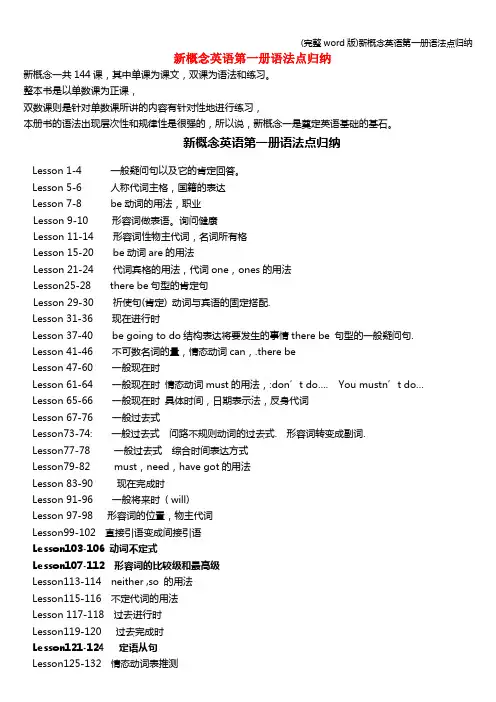
新概念英语第一册语法点归纳新概念一共144课,其中单课为课文,双课为语法和练习。
整本书是以单数课为正课,双数课则是针对单数课所讲的内容有针对性地进行练习,本册书的语法出现层次性和规律性是很强的,所以说,新概念一是奠定英语基础的基石。
新概念英语第一册语法点归纳Lesson 1-4 一般疑问句以及它的肯定回答。
Lesson 5-6 人称代词主格,国籍的表达Lesson 7-8 be动词的用法,职业Lesson 9-10 形容词做表语。
询问健康Lesson 11-14 形容词性物主代词,名词所有格Lesson 15-20 be动词are的用法Lesson 21-24 代词宾格的用法,代词one,ones的用法Lesson25-28 there be句型的肯定句Lesson 29-30 祈使句(肯定) 动词与宾语的固定搭配.Lesson 31-36 现在进行时Lesson 37-40 be going to do结构表达将要发生的事情there be 句型的一般疑问句. Lesson 41-46 不可数名词的量,情态动词can,.there beLesson 47-60 一般现在时Lesson 61-64 一般现在时情态动词must的用法,:don’t do….You mustn’t do…Lesson 65-66 一般现在时具体时间,日期表示法,反身代词Lesson 67-76 一般过去式Lesson73-74: 一般过去式问路不规则动词的过去式. 形容词转变成副词.Lesson77-78 一般过去式综合时间表达方式Lesson79-82 must,need,have got的用法Lesson 83-90 现在完成时Lesson 91-96 一般将来时( will)Lesson 97-98 形容词的位置,物主代词Lesson99-102 直接引语变成间接引语Lesson103-106 动词不定式Lesson107-112 形容词的比较级和最高级Lesson113-114 neither ,so 的用法Lesson115-116 不定代词的用法Lesson 117-118 过去进行时Lesson119-120 过去完成时Lesson121-124 定语从句Lesson125-132 情态动词表推测Lesson133-136 直接引语变间接引语—着重讲时态的倒推Lesson137-140 if 的用法Lesson141-144 被动语态新概念英语一册补充语法:英语数量词大全数词主要分为基数词和序数词两类。
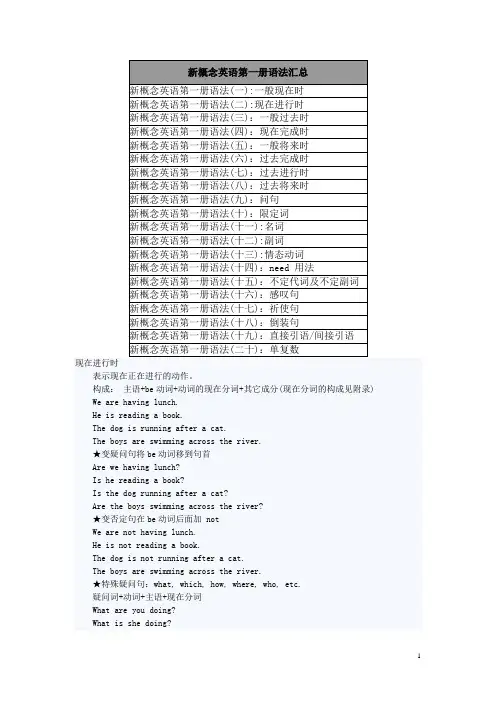
What is the dog doing?没有进行时的动词(必背)表示状态,思想,感情和感觉的动词不能表示正在进行的动作1. 表示感觉,感官的词see, hear, like, love, want,2. have, has当”拥有”讲时没有进行时一、时态:一般现在时,现在进行时,一般过去时,现在完成时,一般将来时,过去进行时,过去完成时,过去将来时1. 一般现在时表示一般性,经常性的动作或一般性事实。
1 含有be动词的句子He is a teacher.The girl is very beautiful.Tim and Jack are students.★变疑问句将be动词移到句首Is he a teacher?Is the girl very beautiful?Are Tim and Jack students?★变否定句在be动词后面加notHe is not a teacher.The girl is not very beautiful.Tim and Jack are not students.★肯定回答及否定回答Yes, he is. No, he is not.Yes, she is. No, she is not.Yes, they are. No, they are not.★不含有be动词的句子,即含有一般动词的句子第三人称单数及单数名词He likes books.She likes him.The dog likes bones.★变疑问句在句首加does, 动词变为原型Does he like books?Does she like him?Does the dog like bones?★变否定句在主语及动词之间加doesn’t, 动词变为原型,原句中的动词不再有第三人称变化。
He doesn’t like books.She doesn’t like him.The dog doesn’t like bones.★肯定回答及否定回答:Yes, he does. No, he doesn’t.Yes, she does. No, she doesn’tYes, it does. No, it doesn’t.注意:第三人称单数形式一般在动词后面加S,不要和名词复数混淆,变否定句或疑问句时名词复数没有任何变化。
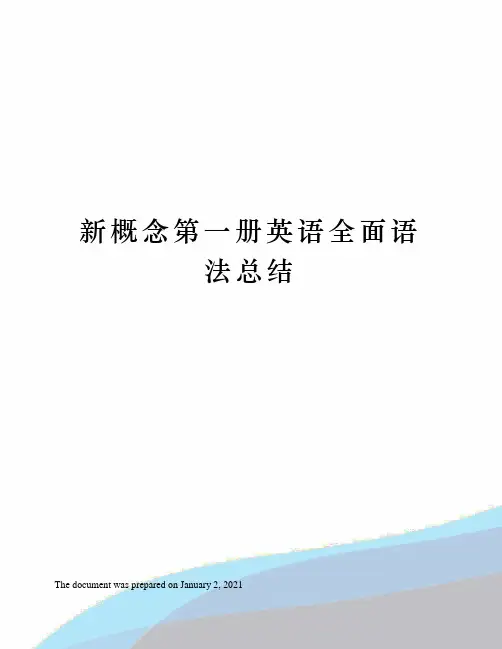
新概念第一册英语全面语法总结The document was prepared on January 2, 2021新概念英语第一册1-72课语法点总结物主代词我的你的他的她的它的我们的你们的他们的形容词性my your his her its our your their 名词性mine yours his hers its ours yours theirs 注意:形容词性物主代词具有依赖性,其后必须紧跟一个名词.人称代词我你他她它我们你们他们主格I you he she it we you they 宾格me you him her it us you them Be动词Be动词在一般现在时的三个变形:am, is, areBe动词在一般过去时的两个变形:was, were注意: Be动词要根据主语的变化而变化.一般疑问句定义:一般疑问句是指可以用Yes或者No回答的句子.肯定句变为一般疑问句:若一个肯定句中存在Be动词am, is, are,则直接将Be动词提前,结尾加问号.若一个肯定句中存在情态动词,则直接将情态动词提前,结尾加问号.若一个肯定句中存在实义动词,则直接在句首加助动词do/does/did,实义动词变原形,结尾加问号.注意:一般疑问句一般读为升调.例:Are you a teacher 你是一名老师吗肯定回答:Yes, I am. 否定回答:No, I am not.Do you like English 你喜欢英语吗肯定回答:Yes, I do. 否定回答:No, I don’t.特殊疑问句定义:不能用Yes或者No回答的句子.构成:特殊疑问词 + 一般疑问句特殊疑问词:what什么, when何时, where何地, who谁, whom谁宾格, whose谁的, which哪个, why为什么, how怎么样口诀:非常八加一不定冠词a/an若单词是以“a, e, i, o”四个元音开头,其前面选用“an”;若单词是以元音字母“u”开头,视情况而定.若其发音与“umbrella”中的“u”一致,则前面加“an”;若其发音与“university”中的“u”一致即发字母本身音时,前面加“a”.若单词是以辅音字母开头,一般前面用a.特殊:an hour 一个小时;an honest boy 一个诚实的男孩若一个字母单独出现时,分如下情况:加an的字母:a, e, i, o元音; x, r, s, l, n, f, m, h 辅音;口诀为“学而思送来那份美好”例: There is an “m” in the word “umbrella”. 在单词umbrella里面有一个字母m.There is a “u” in the word “umbrella”. 在单词umbrella里面有一个字母u.He is an NBA player. 他是一个NBA球员.形容词用法:形容词放在名词或代词前面,对它们起修饰或限定作用.通常用来说明人或事物的大小、颜色、形状、特征等.注意:当形容词单独出现时,前面不可以加a / an.如:Look at that policeman He is a thin. 错误表达正确表达应为:He is a thin man. 或者 He is thin.如果一个名词前有多个形容词修饰,排序口诀:美小圆旧黄,法国木书房.名词所有格构成:一般情况下,有生命的直接在名词后加’ s,无生命的用of.含义:名词所有格表示“…的”.如:my mother’s 我妈妈的 Bob’s 鲍勃的a photograph of our village 我们村庄的一张照片注意:若名词变复数后词尾已经有-s,则只需要在该词尾加“’”例:the workers’ boss 工人们的老板特殊情况:a five minutes’ meeting 一个五分钟的会议a twenty miles’ drive 一个二十公里的车程名词参见课堂上发的名词知识点总结注意:不可数名词在没有量词的情况下,谓语动词一律用单数. There be 句型表示:在某地有某人或某物;在某时发生了某事注意:① Be动词要根据主语的变化而变化.②就近原则:Be动词要根据离其最近的名词的单复数来确定选用is或are,与and后面的名词没有关系.例:There are two girls and a boy under the tree. 在树下有一个男孩和两个女孩. There is a boy and two girls under the tree. 在树下有一个男孩和两个女孩.情态动词must, can注意:情态动词无三单变化,其后加动词的原型.1must①表示“必须”例:What must I do 我必须要做什么You must open the window and air the room. 你必须开窗通风.a.注意:若用must提问,其肯定回答用“must”,否定回答用“needn’t”.例:Must I go to bed before 9 o’clock 我必须在九点之前睡觉吗Yes, you must. 是的,你必须.No, you needn’t. 不,你不需要.b.注意:mustn’t表示严令禁止做某事,翻译成“一定不能…”例:You mustn’t talk in the library. 你绝对不能再图书馆说话.②表示推测,译为“一定是…”例:She looks like Lily. She must be Lily’s mother. 她和Lily长得很像,她一定是Lily的妈妈.You must be a great artist in the future. 你将来一定能成为一名出色的艺术家.c.注意:can’t表示否定的推测,译为“不可能是……”;而不是mustn’t.例:The teacher can’t be in the classroom. I saw her downstairs just now.老师不可能在教室里,我刚在楼下看见她.2can①表示能力,译为“能,会”例:I can bake a cheese cake. 我会做芝士蛋糕.②表示允许,译为“可以”例:Can I eat in the classroom 我能做课堂上吃东西吗Yes, you can. 是的,你可以.No, you can’t. 不,你不能.③“can’t”表示推测,“不可能是…”现在进行时构成:肯定句:主语 + Beam / is / are+ 动词ing否定句:主语 + Be notam not / isn’t / aren’t+ 动词ing一般疑问句:BeAm / Is / Are+ 主语 + 动词ing含义:a.表示说话时正在发生的事例:At the moment, they are playing in the garden. 他们现在正在花园玩.b.表示现阶段正在发生的事例:I am teaching English at XES. 我在学而思教英语.动词变现在分词即ing形式的规则:a.一般动词直接在词尾加ing,如:work---workingb.去掉不发音的e加ing,如:bite---bitingc.重读闭音节即重读辅元辅,双写最后一个辅音字母,加ing,如:run---runningd.若动词以ie结尾,则将ie变为y加ing,如:die---dying; lie---lying标志词:now; at the moment; Look; Listentoday; this morning / afternoon / evening; tonight一般将来时构成:肯定句:主语 + am / is / are going to + 动词原形否定句:主语 + am not / isn’t / aren’t going to + 动词原形一般疑问句:Am / Is / Are + 主语 + going to + 动词原形含义:表示在将来某一时间要发生的动作或存在的状态.时间标志:tomorrow, next week, next month, next year …d.注意:be going to表示计划、准备、打算做某事.例:I am going to pain it pink. 我要把它刷成粉色的.一般现在时构成:a. 当句中动词为Be动词时:肯定句:主语 + Be动词am / is / are + 其它否定句:主语 + Be notam not / isn’t / aren’t+ 其它一般疑问句:Be动词am / is / are+ 主语 + 其它b. 当句中动词为情态动词时:肯定句:主语 + 情态动词 + 其它否定句:主语 + 情态动词 + not + 其它一般疑问句:情态动词 + 主语 + 其它c. 当句中动词为实义动词时:肯定句:主语 + 实义动词 + 其它否定句:主语 + don’t / doesn’t + 实义动词原形 + 其它一般疑问句:Do / Does + 主语 + 实义动词原形 + 其它e.特别注意f.一般现在时,当主语为第三人称单数时,实义动词变其三单形式.和does为一般现在时的助动词,在否定句及疑问句中辅助实义动词使用,当句中有助动词do和does时,实义动词变原形吸星大法 / 照妖镜.实义动词变三单形式的规律:a.多数动词一般在词尾直接加-s,如:work---worksb.以字母o, s, x, ch, sh结尾的动词在词尾加-es记忆口诀:哦撑死是错如:do---does; miss---misses; fix---fixes; watch---watches; wash---washes;c.以辅y结尾的动词将y变i,再加-es,如:study---studiesd.特殊变化,如:have---has用法:a.表示经常性的动作或习惯性的动作,常与表示频率的时间状语连用例句:Mrs. Sawyer stays at home every day.b.表示主语具备的性格、能力、特征He is a careless boy. 他是一个粗心的男孩.c.表示一种状态There is a picture of his dog on the wall. 墙上挂着一张他狗狗的照片.d.表示客观事实和普遍真理The earth moves around the sun. 地球围着太阳转.标志词:频率副词always; usually; often; sometimes; rarely; neverevery…每个…; once……一次; twice……两次; …times …几次in the morning / afternoon / evening; at noon / night; on Sundays 注意:频率副词的位置在Be动词和助动词的后面,实义动词的前面.口诀:Be助后,实义前双宾语构成:①主语 + 动词 + 间接宾语 + 直接宾语②主语+ 动词 + 直接宾语 + to / for + 间接宾语to强调动作的方向,可译为“对着某人”;for强调动作的目的,可译为“为了某人”.加to的动词:give, show, pass, lend, take, tell 等加for的动词:buy, get, make, sing, read, cook 等口诀:爸爸给妈妈送热菜不定代词any和somesome和any既可以修饰可数名词,也可以修饰不可数名词some和any的用法区别定义:提出两种或两种以上的情况,要求对方选择一种情况回答,这种问句叫做选择疑问句.分类:(1)一般选择疑问句构成:一般疑问句 + 被选择的情况例句:Do you want tea or coffee 你想要茶还是咖啡(2)特殊选择疑问句构成:特殊疑问句,A or B例句:What would you like, tea or coffee 你想要什么,是茶还是咖啡注意:当备选情况多于两种时,仅在最后两个备选情况之间加or例:What would you like, tea, coffee, or orange juice 你想要什么,茶、咖啡还是橙汁the + 姓氏的复数 / the + 姓氏 + family表示一家人例:the Sawyers / the Sawyer family 索耶尔一家时间表达法1.对时间的提问a.What time is itb.What’s the timec.d.e.Could you tell me the timef.g.h.Excuse me Have you got the timei.j.2.整点表达法整点数字 + o’clock,如:6 o’clock 六点3.顺读法先读小时,后读分钟,如:six forty 六点四十4.逆读法当分针不足三十分钟时,用past,读为几点过几分,如:ten past six 六点十分当分针大于三十分钟时,用to,读为差几分几点,如:ten to six 五点五十注意:半点读为half past…,如:half past six 六点半一刻还可以读为a quarter例:a quarter past six 六点一刻;a quarter to six 五点四十五时间介词1at + 时刻 / 年龄如:at six o’clock在六点;;at twenty years old 在二十岁的时候at的固定搭配:at night / at noon2on + 具体到某一天的时间 / 特定的、有修饰的早、中、晚如:on Monday 在周一;on Mother’s Day 在母亲节如:on Sunday afternoon 在周日的下午;on a sunny morning 在一个阳光明媚的早晨; on the evening of May 1st在五月一日的晚上3in + 不能具体到某一天的时间>天如:in spring 在春天;in March 在三月;in 2010 在2010年;in的固定搭配:in the morning; in the afternoon; in the evening此处的早、中、晚无修饰祈使句及祈使句的否定式祈使句一般省略主语you,以动词原形直接开头,表示请求、劝告、命令、禁止等.祈使句的否定形式在句首直接加Don’t.例句:Open the window 打开窗户Don’t open the window 不许打开窗户反身代词反身代词的常见固定短语:enjoy oneself 玩得开心;自得其乐 cut oneself 受伤 hurt oneself 受伤 by oneself 独自 teach oneself 自学 dress oneself 自己穿衣服 help yourself to…自己随便吃点…例:We always enjoy ourselves. 我们总是玩得很开心.Please do your homework by yourself. 请自行完成作业.Help yourself to some fish. 请自己随便吃点鱼肉.一般过去时构成:a. 当句中动词为Be动词时:肯定句:主语 + Be动词was / were + 其它否定句:主语 + Be notwasn’t / weren’t+ 其它一般疑问句:Be动词was / were+ 主语 + 其它b. 当句中动词为实义动词时:肯定句:主语 + 实义动词的过去式 + 其它否定句:主语 + didn’t + 实义动词原形 + 其它一般疑问句:Did + 主语 + 实义动词原形 + 其它a.特别注意b.一般过去时句中动词要变成其过去式.c.有些情态动词有过去式,如can的过去式为could;有些情态动词的过去式保持不变,如must用于过去时态依然为must.为一般现在时的助动词,在否定句及疑问句中辅助实义动词使用,当句中有助动词did时,实义动词变原形吸星大法 / 照妖镜.动词变过去式的规则:a.一般动词直接在词尾加ed,如:work---worked; play---playedb.以不发音的e结尾,直接在词尾加d,如:move---movedc.以辅音字母加y结尾的动词,把y变i再加ed,如:study---studiedd.以重读闭音节即重读辅元辅结尾,双写最后一个辅音字母,再加ed,如stop---stoppede.不规则动词的过去式变化keep---kept; feel---felt; sleep---slept; sweep---sweptbuild---built; lend---lent; send---sent; spend---spentring---rang; sit---sat; drink---drank; sing---sang; swim---swam; begin---began; give---gaveride---rode; drive---drove; write---wrotethink---thought; buy---bought; bring---brought; fight---foughtteach---taught; catch---caughtknow---knew; grow---grew; draw---drewput---put; let---let; read---read口诀:直去双改特含义:表示在过去一个确切的时间发生并且已经结束的动作.简称:过去的确切标志词:just now; yesterday; ago; last; before; when + 过去时间; this系列乘坐交通工具表达法By: by bike / bus / car / subway / train / plane / air / boat / ship 注意by后无冠词Take: take a / an / the bus / car / taxi / train / planeon foot 步行新概念英语第一册73-96课语法点总结(一)副词的构成及用法1.构成a.有些形容词直接在词尾加-ly变为副词如:careful 小心的 --- carefully 小心地;quick 快的 --- quickly 快地b.有些以辅音字母加y结尾的形容词,把y变为i,加-ly,如:happy---happilyc.有些词的形容词形式与副词形式相同,如:late, hard如:You are late. 你迟到了.形容词I went to bed late yesterday. 我昨天睡得很晚.副词It is a hard rock. 这真是一块硬石头.形容词She studies hard. 她学习很努力.副词注意:不要将lately及hardly混淆为late及hard的副词.lately译为“最近”;hardly译为“几乎不”,为否定词.d.少数以le结尾的形容词变副词时,去掉e加y,如:terrible---terribly; gentle---gentlye.以两个l结尾的形容词,直接在词尾加y,如:full---fully2.用法副词主要修饰动词,其还可以修饰形容词及副词.如:He runs quickly. 他跑得快.副词修饰动词He is very handsome. 他长得很帅.副词修饰形容词He runs very fast. 他跑得非常快.副词修饰副词3.位置副词修饰动词时,一般放在所修饰动词的后面.频率副词的位置:Be动词、助动词的后面;实义动词的前面.口诀:Be助后,实义前(二)have与have got的用法1.含义have和have got都表示“有”2.用法区别have可以用在正式或非正式的场景中;have got常用在口语等非正式的场景中.3.否定形式及疑问形式的区别a.have为实义动词,变否定及疑问句时需要助动词的帮助例:肯定句:I have a book.否定句:I don’t have a book.一般疑问句:Do you have a bookb.have got可看成是助动词have加动词的过去分词形式,have即为助动词例:肯定句:I have got an apple.否定句:I haven’t got an apple.一般疑问句:Have you got an apple(三)行为动词have1.含义have可以表示“吃”、“喝”、“从事”等意义.2.have的词组have fun 玩得高兴 have a good time 玩得高兴 have a rest 休息 have a bath 洗澡 have a swim 游泳 have a holiday 度假 have a cigarette 抽烟 have breakfast 吃早餐 have lunch 吃午餐 have supper 吃晚餐 have dinner 吃晚餐have a meal 吃饭have to 不得不(四)现在完成时小升初重点a.构成a. 肯定句:主语 + have/has + 动词的过去分词 + 其它例句:I have just finished my homework. 我刚刚写完作业.b. 否定句:主语 + have/has + not + 动词的过去分词 + 其它例句:I haven’t finished my homework yet. 我还没有写完作业.c. 疑问句:Have/Has + 主语 + 动词的过去分词 + 其它例句:Have you finished your homework 你写完作业了吗b.动词变其过去分词形式大多数动词的过去分词与过去式相同,遵循口诀“直去双改特”变化,为ABB型.另外还有AAA型,如cut cut cut;ABA型,如come came come;ABC型,如go went gone; do/does did done.c.含义a.已完成:一个动作发生在过去,已结束,并对现在产生影响.例句: I have just finished my homework. 我刚刚写完作业了.暗指现在我可以出去玩了与一般过去时的区别:强调对现在的影响.标志词:just, never, ever, already, yet注意:若句中出现明显的表示过去的时间,要用一般过去时.一般过去时为“过去的确切”,现在完成时为“过去的模糊”.b.未完成:一个动作从过去开始,一直持续到现在,并有可能继续持续.例句:Zoe has studied English for ten years. Zoe已经学了十年的英语了.例句:Zoe has studied English since ten years ago. Zoe从十年前就已经开始学英语了.标志词:for, since, up to now, up till now, by完成时好朋友与since的区别: 长达…时间加时间段强调某动作持续了多长时间.since: 自从…加时间点或过去发生的动作强调某动作是从何时开始的.e.常考短语一.have gone to 到某地去了去了;未归例句:Zoe has gone to America. Zoe去美国了.二.have been to 曾经去过某地去过;已归例句:Zoe has been to America. Zoe曾经去过美国.f.特别注意a现在完成时标志词口诀:just easy & funalready经常用于肯定句中; yet置于句尾;常用于疑问句及否定句中;just; ever; since; for; up to now; up till now; neverb现在完成时常与次数连用,表示某动作已经做过N次了.例句:I have seen the movie three times. 这部电影我已经看过三次了.(五)一般将来时1.构成1.shall(1)用法:只用于主语为第一人称I, we时(2)构成肯定句:主语 + shall + 动词原形否定句:主语 + shall not shan’t + 动词原形一般疑问句:Shall + 主语 + 动词原形2.will(1)用法:最常用;适用于所有人称(2)构成1肯定句:主语 + will + 动词原形2否定句:主语 + will not won’t + 动词原形3一般疑问句:Will + 主语 + 动词原形(3)特殊用法:will用于表示将要到达的年及年龄.例句:I will be thirty years old next year. 我明年就三十岁了.3.be going to(1)用法:表示计划、打算、准备做某事(2)构成a.肯定句:主语 + am / is / are going to + 动词原形b.否定句:主语 + am not / isn’t / aren’t going to + 动词原形c.一般疑问句:Am / Is / Are + 主语 + going to + 动词原形(3)特殊用法:be going to用于有迹象表明将要发生的天气.例句:Look at the black clouds outside. It is going to rain. 看外面的乌云啊,要下雨了.2.含义:表示在将来某一时间要发生的动作或存在的状态.3.标志词:tomorrow; next; future; soon; from now on; in+段时间(六)had better1.含义:had better表示“最好还是……”,用于提出建议、劝告或表达一种愿望.2.用法had better中的had不表示过去时间,不论第几人称、什么时态,均用此形式.had better后加动词原形had better do sth. 最好做某事; had better not do sth. 最好不要做某事例句:You’d better get up before six o’clock. 你最好在六点之前起床.You’d better not dance in the classroom. 你最好不要在教室里跳舞.新概念英语第一册97-112课语法点总结1.代词物主代词译为“谁的”我的你的他的她的它的我们的你们的他们的形容词性my your his her its our your their 复习名词性新mine yours his hers its ours yours theirs 授注意:形容词性物主代词具有依赖性,其后必须紧跟一个名词.注意:名词性物主代词 = 形容词性物主代词 + 名词例:This is my suitcase. 或 This suitcase is mine. 这是我的手提箱.人称代词译为“谁”我你他她它我们你们他们主格I you he she it we you they宾格me you him her it us you them注意:人称代词的主格用于主语,即动作的发出者;人称代词的宾格用于宾语,即动作的承受者.2.宾语从句1.定义在句子中起宾语作用的从句叫做宾语从句.2.类型a.陈述句引导词:that;that可省略例:I think that it is a cock. 我认为它是一只公鸡.b.一般疑问句引导词:if或whether,译为“是否”.例:一般疑问句:Does he like English 他喜欢英语吗宾语从句:I want to know whether / if he likes English. 我想知道他是否喜欢英语.c.特殊疑问句引导词:特殊疑问词例:特殊疑问句:Why did I die 为什么我死了宾语从句:Paul asked why he died. 章鱼保罗问为什么他死了.3.使用三原则a.时态呼应b.语序正常;宾语从句使用陈述句语序.判断标准:引导词后紧跟主语.c.真理规律永不变3.直接引语和间接引语1.定义直接引语:直接引用别人的话间接引语:间接转述别人的话2.直接引语变间接引语口诀:人变变,动变变,句子的顺序变一变,关键词也要来变变.4.反义疑问句1.构成反义疑问句由两部分构成,前面是一个陈述句,后面是一个简略的疑问句.2.含义反义疑问句可以用来确定自己的判断,获取真实的信息,还可以用来表示惊讶、愤怒等感情.3.形式如果前面的陈述句是肯定形式,后面的简略疑问句用否定形式;如果前面的陈述句是否定形式,后面的简略疑问句用肯定形式.简称:前肯后否,前否后肯注意:反义疑问句回答真实情况.例:He doesn’t say very much, does he 他没说很多,不是吗Yes, he does. 不,他说了很多.No, he doesn’t. 对,他没说很多.; very; enough1.too的用法a.表示“太……”,修饰形容词或副词,常含有贬义色彩.例:She can’t move the case. It’s too heavy. 她移不动那只箱子,它太沉了.b.too…to…句型例:She is too busy to talk with me. 她太忙了,没时间和我说话.2.very的用法表示“很”或“非常”例:The book is very interesting. 这本书非常有趣.3.enough的用法a.enough + 名词例:There are enough books for the children to read.有足够的书供孩子们阅读.b.形容词 + enough例:The exam is easy enough for her to pass.那次考试够简单,她可以及格.c.be enough to do…足够…可以做…例:He is old enough to make his own decision.他已经长大了,可以自己做决定了.6.动词不定式动词+to do形式肯定形式:want sb. to do sth. 想让某人做某事例:I want you to correct it. 我想让你把它改正过来.ask sb. to do sth. 让某人做某事例:Her teacher asked her to correct it. 她的老师让她改正过来.tell sb. to do sth. 告诉某人做某事例:His mother tells him to go to bed. 他妈妈告诉他去睡觉.否定形式:don’t / doesn’t want sb. to do sth. 想让某人不要做某事例:I don’t want you to correct it. 我不想让你改正它.ask sb. not to do sth. 让某人不要做某事例:Her teacher asked her not to correct it. 她的老师让她不要改正它.tell sb. not to do sth. 告诉某人不要做某事例:His mother tells him not to go bed. 他的妈妈告诉他不要睡觉.7.祈使句祈使句的作用是要求、请求或命令、劝告、建议别人做或不做一件事.祈使句的句末一般用感叹号,但是有些祈使句的语气较弱,可以用句号结尾.肯定结构:1.Do型以实义动词原型直接开头例:Listen to me carefully. 认真听我说.2.Be型例:Be a good boy 做一个好孩子.3.Let型例:Let me help you. 让我来帮你.Let’s go swimming together. 我们一起去游泳吧.否定结构:1.Do型和Be型的否定式都是在句首加Don’t构成.例:Don’t forget me 不要忘记我Don’t be late for school 上学不要迟到2.Let型的否定式有两种:1. Don’t let sb. do sth. 例:Don’t let him go. 别让他走.2. Let sb. not do sth. 例:Let him not go. 别让他走.注意:当为“Let sb. do sth.”的形式时,多用第一种;当为“Let’s do sth.”的形式时,多用第二种.8.形容词的比较级、最高级1.形容词比较级最高级的变化规则:级和最高级-the least beautiful漂亮;丑一点;最丑特殊变化原级比较级最高级good better bestbad worse worstlittle less least many / much more most far farther / further farthest /furthest old older / elder oldest / eldest2.比较级的标志词两者之间的比较,句中有than例:Vickie is more beautiful than her sister. Vickie比她的姐姐更漂亮.注意:more与-er不能同时出现在一句话中表示同一个词的比较级.如:Vickie is cleverer than her sister. 正确Vickie is more clever than her sister. 正确Vickie is more cleverer than her sister. 错误3.比较级的修饰词表示“……得多”:much; far; a lot例:An elephant is much / far / a lot bigger than an ant. 大象比蚂蚁要大得多.表示“只……一点”:a little; a bit例:An elephant is a little / a bit heavier than a truck. 大象比大卡车只重一点.9.形容词的同级比较1.肯定结构:as … as …和……一样……例:Mr. Big is as tall as Mr. Small. 大先生和小先生一样高.2.否定结构:not … as … as …; not … so … as …和……不一样例:Triangle A is not as big as triangle B. 三角形A和三角形B不一样大.或:Triangle A is not so big as triangle B. 三角形A和三角形B不一样大. 10.形容词的递减级比较形式:less + 形容词的原级,表示“更不……”least + 形容词的原级,表示“最不……”例:less expensive 更便宜更不贵least expensive 最便宜最不贵less difficult 更简单更不难least difficult 最简单最不难新概念英语第一册113-144课语法点总结一.so / neither引导的简短回答a.结构:1.so / neither + be动词 + 主语例:He is a dancer, so am I. 他是个舞蹈家,我也是.2.so / neither + 情态动词 + 主语例:He can dance very well, so can I. 他跳舞跳得很好,我也是.3.so / neither + 助动词 + 主语例:He doesn’t like singing, neither do I. 他不喜欢唱歌,我不喜欢.b.表示某人也是,某人也会,某人也不是,某人也不会.c.区别如果前一句是肯定的,后一句用so开头;如果前一句是否定的,后一句用neither开头.二.not a an / any & no & none1.no是个限定词,用在名词前,等同于not a或not any,用来强调句子的否定含义.例:I haven’t got any fingers. = I have got no fingers. 我没有手指.I haven’t got a long tail. = I have got no long tail. 我没有一条长尾巴.2.none : 没有人;一个也没有;一点儿也没有例:He has got many interesting books. I have got none.他有很多有趣的书,我一本也没有.三.不定代词either; both; all; neither; none例:Which one do you want, an apple or a pear Either is Okay.你想要苹果还是梨都可以.Either of my parents will come to see you. 我爸爸或者妈妈会来见你.不定代词的词组:1.both … and …两者都……例:Both Lily and Linda are right. Lily和Linda都是对的.注意:both … and …连接名词或代词作主语时,谓语动词用复数形式.2.neither … nor …既不…也不…例:Neither Lily nor Linda is right. Lily和Linda都不对.注意:neither … nor …可连接任意两个并列的成分,其谓语动词遵循“就近原则”.例:Neither he nor I am right. 或 Neither I nor he is right. 我也不对,他也不对.3.either … or …或者…或者…例:Either Lily or Linda is right. 要么Lily是对的,要么Linda是对的.注意:either … or …连接句子中两个并列成分,其谓语动词遵循“就近原则”.例:Either he or I am right. 或 Either I or he is right. 要么我是对的,要么他是对的.四.复合不定代词、复合副词一复合不定代词1.定义由some-, any-, no-, every- 加上-one, -body, -thing等组成的不定代词.注意除no one中间有空格外,其余复合不定代词均需要连写,中间不允许有空格.注意nothing的读法.二复合副词1.定义由some-, any-, no-, every- 加上-where所组成的是表示地点的副词.1.复合不定代词作主语时,谓语动词用三单形式.。
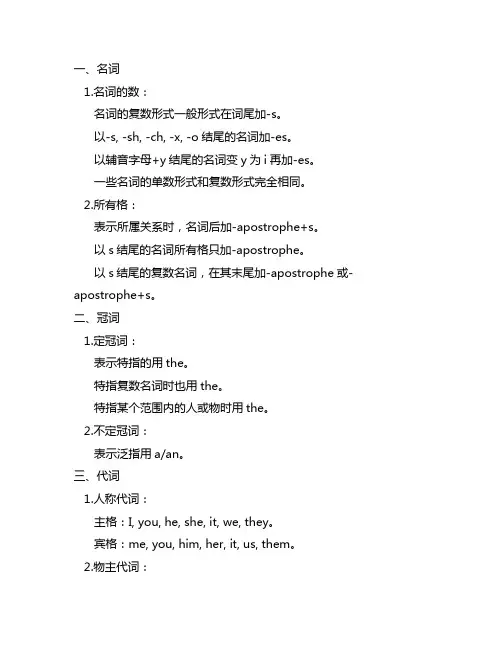
一、名词1.名词的数:名词的复数形式一般形式在词尾加-s。
以-s, -sh, -ch, -x, -o结尾的名词加-es。
以辅音字母+y结尾的名词变y为i再加-es。
一些名词的单数形式和复数形式完全相同。
2.所有格:表示所属关系时,名词后加-apostrophe+s。
以s结尾的名词所有格只加-apostrophe。
以s结尾的复数名词,在其末尾加-apostrophe或-apostrophe+s。
二、冠词1.定冠词:表示特指的用the。
特指复数名词时也用the。
特指某个范围内的人或物时用the。
2.不定冠词:表示泛指用a/an。
三、代词1.人称代词:主格:I, you, he, she, it, we, they。
宾格:me, you, him, her, it, us, them。
2.物主代词:形容词性物主代词:my, your, his, her, its, our, their。
名词性物主代词:mine, yours, his, hers, its, ours, theirs。
3.指示代词:this, that, these, those。
4.不定代词:some, any, no, every, each, many, much, few, little。
四、形容词1.形容词的用法:在名词前作定语。
在系动词之后作表语。
2.比较级和最高级:比较级:比较两者时,用比较级。
最高级:表示三者或三者以上之间的比较。
五、动词1.动词的三单形式:一般情况,动词第三人称单数在末尾加-s。
以辅音字母加y结尾的动词变y为i再加-es。
直接在词尾加-es的动词。
2.动词的现在进行时:am/is/are+动词的现在分词。
3.行为动词的过去式:动词过去式变化规则有规则动词和不规则动词。
六、副词1.副词的用法:修饰动词、形容词、副词。
表示时间、地点、原因、目的等。
2.比较级和最高级:副词比较级和最高级的构成。
七、介词1.介词的基本用法:表示方位、时间、原因、目的等。
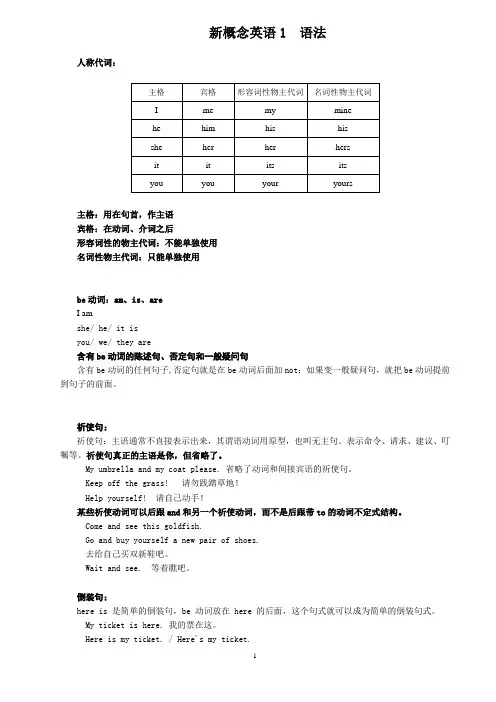
新概念英语1 语法人称代词:主格:用在句首,作主语宾格:在动词、介词之后形容词性的物主代词:不能单独使用名词性物主代词:只能单独使用be动词:am、is、areI amshe/ he/ it isyou/ we/ they are含有be动词的陈述句、否定句和一般疑问句含有be动词的任何句子,否定句就是在be动词后面加not;如果变一般疑问句,就把be动词提前到句子的前面。
祈使句:祈使句:主语通常不直接表示出来,其谓语动词用原型,也叫无主句。
表示命令、请求、建议、叮嘱等。
祈使句真正的主语是你,但省略了。
My umbrella and my coat please. 省略了动词和间接宾语的祈使句。
Keep off the grass! 请勿践踏草地!Help yourself! 请自己动手!某些祈使动词可以后跟and和另一个祈使动词,而不是后跟带to的动词不定式结构。
Come and see this goldfish.Go and buy yourself a new pair of shoes.去给自己买双新鞋吧。
Wait and see. 等着瞧吧。
倒装句:here is 是简单的倒装句,be 动词放在 here 的后面,这个句式就可以成为简单的倒装句式。
My ticket is here. 我的票在这。
Here is my ticket. / Here's my ticket.冠词:冠词数量上表示“一个”。
冠词一共有三个,分为不定冠词和定冠词。
1、a, an 是不定冠词:可数名词单数前面必须要用不定冠词a 用在以辅音音素开头的名词前面,an 用于以元音音素(元音发音的单词)开头的名词前面a pen an apple an umbrella an egg an hour a university2、the 是定冠词,表示特指,有两种发音:以元音发音开头的单词前面读[ ]。
当想使听话者特别注意the后面的名词时,the就读为[ ],意思是“这一个而且只是这一个”或“主要是这一个”。
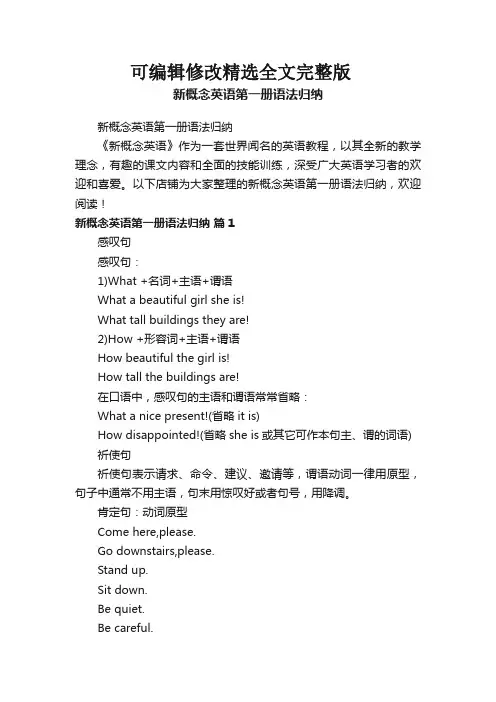
可编辑修改精选全文完整版新概念英语第一册语法归纳新概念英语第一册语法归纳《新概念英语》作为一套世界闻名的英语教程,以其全新的教学理念,有趣的课文内容和全面的技能训练,深受广大英语学习者的欢迎和喜爱。
以下店铺为大家整理的新概念英语第一册语法归纳,欢迎阅读!新概念英语第一册语法归纳篇1感叹句感叹句:1)What +名词+主语+谓语What a beautiful girl she is!What tall buildings they are!2)How +形容词+主语+谓语How beautiful the girl is!How tall the buildings are!在口语中,感叹句的主语和谓语常常省略:What a nice present!(省略it is)How disappointed!(省略she is或其它可作本句主、谓的词语) 祈使句祈使句表示请求、命令、建议、邀请等,谓语动词一律用原型,句子中通常不用主语,句末用惊叹好或者句号,用降调。
肯定句:动词原型Come here,please.Go downstairs,please.Stand up.Sit down.Be quiet.Be careful.祈使句中如果有唤语,一定要用逗号隔开,放在句首或者句尾:Come in,Amy.Sit down here,Tom.Mary,give me a book please.否定:Don't+动词原型Don't come here.Don't sit down.Don't stand up.Don't give me it.let sb. do 让某人做Let me pass.Let us have a rest.Let's have a rest.反意疑问:Let's have a walk along the river,shall we?Let us go out for a drink,will you?so/neither的倒装倒装句:so/neither的倒装eg: He can swim. So can I.She didn't go to class. Neither did I.结构:so/neither+be+ 主语so/neither+助动词+ 主语so/neither+情态动词+ 主语助动词:一般现在时: do,does/am,is,are现在进行时: am,is,are一般过去时: did现在完成时: have,has一般将来时: will,shall过去进行时: was,were过去完成时: had过去将来时: would直接引语/间接引语如果引语的主句所用动词为过去时,那么间接引语要做相应变化:时态,人称,时间地点及指示词1)时态变化:一般现在时——一般过去时现在进行时——过去进行时一般过去时——过去完成时现在完成时——过去完成时一般将来时——过去将来时be going to——was/were going to/wouldcan--couldmay--might2)时间地点及指示词的变化:here-there,tomorrow-the next day,the following day,this-that…3)人称变化:根据句意改变人称。
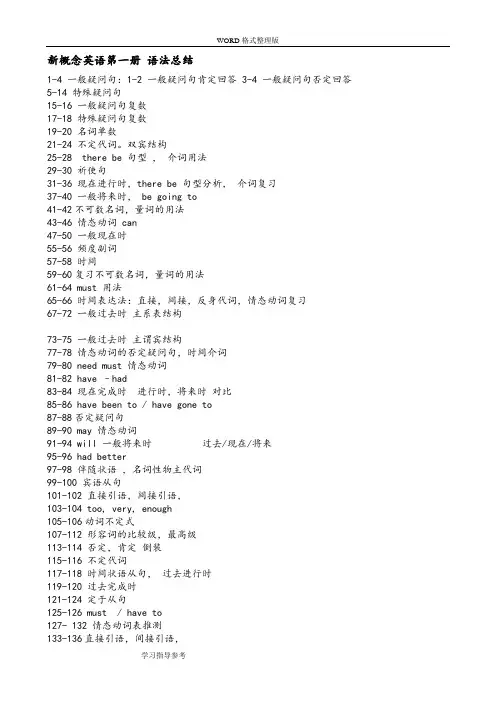
新概念英语第一册语法总结1-4 一般疑问句:1-2 一般疑问句肯定回答 3-4 一般疑问句否定回答5-14 特殊疑问句15-16 一般疑问句复数17-18 特殊疑问句复数19-20 名词单数21-24 不定代词。
双宾结构25-28 there be 句型,介词用法29-30 祈使句31-36 现在进行时,there be 句型分析,介词复习37-40 一般将来时, be going to41-42不可数名词,量词的用法43-46 情态动词 can47-50 一般现在时55-56 频度副词57-58 时间59-60复习不可数名词,量词的用法61-64 must 用法65-66 时间表达法:直接,间接,反身代词,情态动词复习67-72 一般过去时主系表结构73-75 一般过去时主谓宾结构77-78 情态动词的否定疑问句,时间介词79-80 need must 情态动词81-82 have –had83-84 现在完成时进行时,将来时对比85-86 have been to / have gone to87-88否定疑问句89-90 may 情态动词91-94 will 一般将来时过去/现在/将来95-96 had better97-98 伴随状语,名词性物主代词99-100 宾语从句101-102 直接引语,间接引语,103-104 too, very, enough105-106动词不定式107-112 形容词的比较级,最高级113-114 否定,肯定倒装115-116 不定代词117-118 时间状语从句,过去进行时119-120 过去完成时121-124 定于从句125-126 must / have to127- 132 情态动词表推测133-136直接引语,间接引语,137-138 条件状语从句139-140宾语从句141-144 被动语态Lesson 1 Excuse me1. Words1) excuse (1)重音(2)与sorry 的区别(3)Excuse 用的不同场景a. 请别人让路b. 引起别人的注意c. 打断别人的谈话d. 可以当n. 借口 eg. No excuse. 别找借口,没有借口。
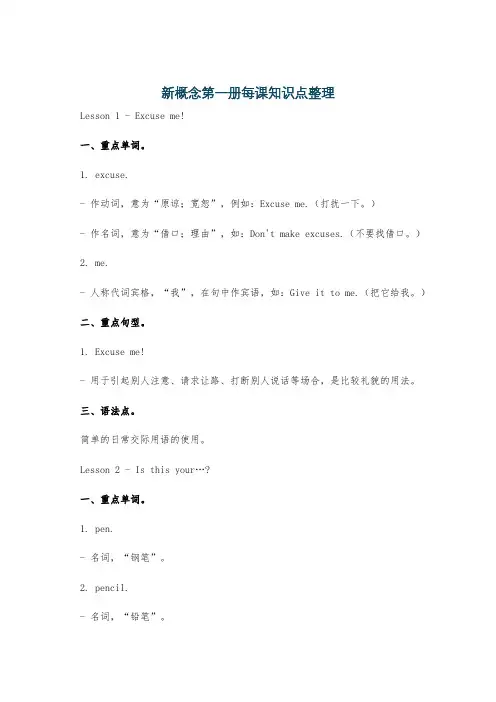
新概念第一册每课知识点整理Lesson 1 - Excuse me!一、重点单词。
1. excuse.- 作动词,意为“原谅;宽恕”,例如:Excuse me.(打扰一下。
)- 作名词,意为“借口;理由”,如:Don't make excuses.(不要找借口。
)2. me.- 人称代词宾格,“我”,在句中作宾语,如:Give it to me.(把它给我。
)二、重点句型。
1. Excuse me!- 用于引起别人注意、请求让路、打断别人说话等场合,是比较礼貌的用法。
三、语法点。
简单的日常交际用语的使用。
Lesson 2 - Is this your…?一、重点单词。
1. pen.- 名词,“钢笔”。
2. pencil.- 名词,“铅笔”。
3. book.- 名词,“书”。
4. watch.- 名词,“手表”;也可作动词,“观看”,如:watch TV(看电视)。
二、重点句型。
1. Is this your pen?- 这是一般疑问句,其结构为“be动词(is/are等)+主语+其他”,回答可以是“Yes, it is.”或者“No, it isn't.”三、语法点。
1. 一般疑问句的构成与回答。
2. 指示代词this的用法,用来指代离说话者较近的人或物。
Lesson 3 - Sorry, sir.一、重点单词。
1. umbrella.- 名词,“雨伞”。
2. please.- 副词,用于请求别人做某事时表示礼貌,如:Please open the window.(请打开窗户。
)二、重点句型。
1. Is this your umbrella?- 同Lesson 2中的一般疑问句结构。
2. Sorry, sir.- “sorry”表示歉意,“sir”是对男性的尊称。
三、语法点。
1. 继续巩固一般疑问句。
2. 尊称“sir”的用法。
Lesson 4 - Is this your…?一、重点单词。
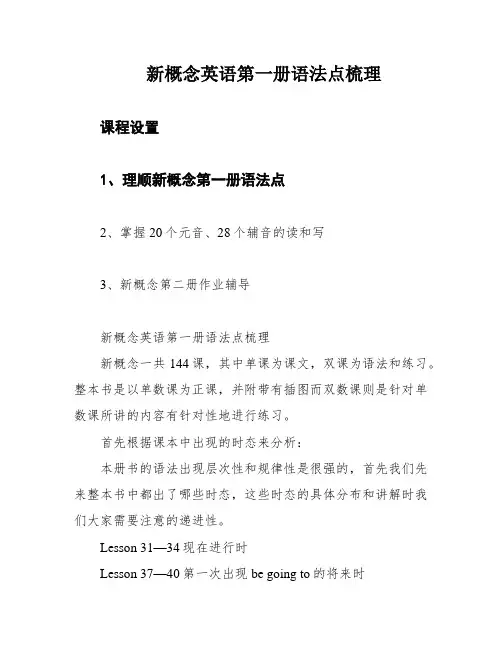
新概念英语第一册语法点梳理课程设置1、理顺新概念第一册语法点2、掌握20个元音、28个辅音的读和写3、新概念第二册作业辅导新概念英语第一册语法点梳理新概念一共144课,其中单课为课文,双课为语法和练习。
整本书是以单数课为正课,并附带有插图而双数课则是针对单数课所讲的内容有针对性地进行练习。
首先根据课本中出现的时态来分析:本册书的语法出现层次性和规律性是很强的,首先我们先来整本书中都出了哪些时态,这些时态的具体分布和讲解时我们大家需要注意的递进性。
Lesson 31—34现在进行时Lesson 37—40第一次出现be going to的将来时Lesson 51—56一般现在时Lesson 67—76一般过去式Lesson 83—90现在完成时Lesson 91—96一般将来时(will)Lesson 117—118曩昔举行时Lesson 119—120曩昔完成时除去前面一切时态和句型所占领的76课我们一起来看一下以下的68课,每课小的语言点,语法点都是在甚么中央,应当用甚么样的方式来说解。
新概念一的每一个单课的重点都是出现双课的标题和课后的练习题里面。
Lesson1—2语言点:与陌生人说话或引起别人的注意。
Excuse me. Yes? Pardon? Thank you very much.语法点:主系表结构this为主语,名词做表语1的一般疑问句以及它的肯定回答。
Is this your handbag? Yes,it is.Lesson 5—6语言点:如何介绍别人。
This is Miss Sophie Dupont. Nice to meet you.语法点:主语为第三人称单数的主系表布局。
She is French. He is German. It’s a Volvo.(L6)a/an的使用。
Lesson 7—8语言点:如何自我介绍和相互认识。
语法点:主语为第二人称的主系表布局。
Are you French?What nationality are you? What’s your job?非凡疑问句。
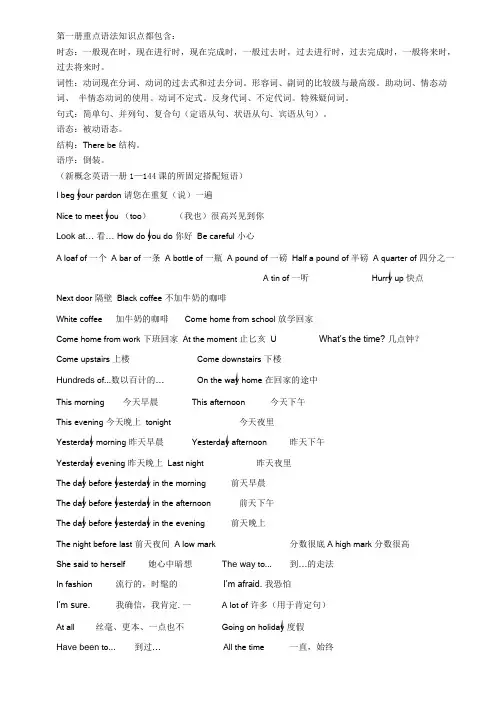
第一册重点语法知识点都包含:时态:一般现在时,现在进行时,现在完成时,一般过去时,过去进行时,过去完成时,一般将来时,过去将来时。
词性:动词现在分词、动词的过去式和过去分词。
形容词、副词的比较级与最高级。
助动词、情态动词、半情态动词的使用。
动词不定式。
反身代词、不定代词。
特殊疑问词。
句式:简单句、并列句、复合句(定语从句、状语从句、宾语从句)。
语态:被动语态。
结构:There be结构。
语序:倒装。
(新概念英语一册1—144课的所固定搭配短语)I beg your pardon 请您在重复(说)一遍Nice to meet you (too)(我也)很高兴见到你Look at… 看… How do you do 你好Be careful 小心A loaf of 一个 A bar of 一条 A bottle of 一瓶 A pound of 一磅Half a pound of 半磅 A quarter of 四分之一A tin of 一听Hurry up 快点Next door 隔壁Black coffee 不加牛奶的咖啡White coffee 加牛奶的咖啡Come home from school放学回家Come home from work 下班回家At the moment 止匕亥U What’s the time? 几点钟?Come upstairs 上楼Come downstairs 下楼Hundreds of...数以百计的…On the way home 在回家的途中This morning 今天早晨This afternoon 今天下午This evening 今天晚上tonight 今天夜里Yesterday morning 昨天早晨Yesterday afternoon 昨天下午Yesterday evening 昨天晚上Last night 昨天夜里The day before yesterday in the morning 前天早晨The day before yesterday in the afternoon 前天下午The day before yesterday in the evening 前天晚上The night before last 前天夜间 A low mark 分数很底A high mark 分数很高She said to herself 她心中暗想The way to... 到…的走法In fashion 流行的,时髦的I’m afraid. 我恐怕I’m sure.我确信,我肯定.一 A lot of 许多(用于肯定句)At all 丝毫、更本、一点也不Going on holiday 度假Have been to... 到过…All the time 一直,始终Have been to…到过…Drive into…撞倒.•・For sale 供出售、出售Have the last word 最后决定、最后才算The R.A.F. 英国皇家空军Return ticket 往返票Next door to... 与..•相邻,在..•隔壁In five hours’time在五小时之后。
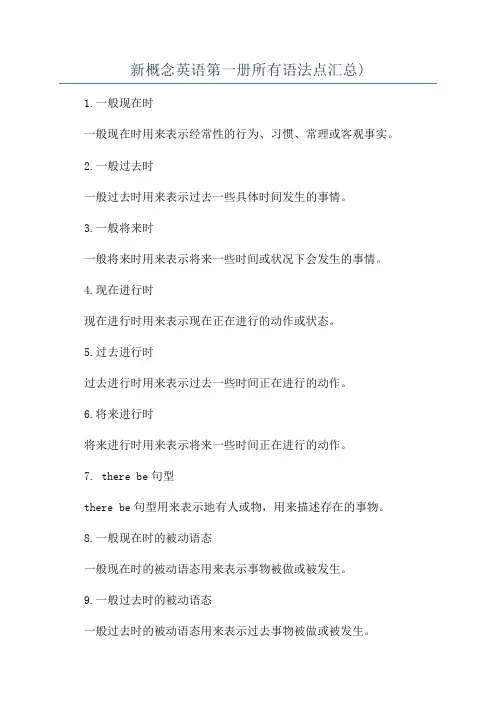
新概念英语第一册所有语法点汇总)1.一般现在时一般现在时用来表示经常性的行为、习惯、常理或客观事实。
2.一般过去时一般过去时用来表示过去一些具体时间发生的事情。
3.一般将来时一般将来时用来表示将来一些时间或状况下会发生的事情。
4.现在进行时现在进行时用来表示现在正在进行的动作或状态。
5.过去进行时过去进行时用来表示过去一些时间正在进行的动作。
6.将来进行时将来进行时用来表示将来一些时间正在进行的动作。
7. there be句型there be句型用来表示地有人或物,用来描述存在的事物。
8.一般现在时的被动语态一般现在时的被动语态用来表示事物被做或被发生。
9.一般过去时的被动语态一般过去时的被动语态用来表示过去事物被做或被发生。
10.一般将来时的被动语态一般将来时的被动语态用来表示将来事物将被做或被发生。
11.现在进行时的被动语态现在进行时的被动语态用来表示事物正在被做或被发生。
12.过去进行时的被动语态过去进行时的被动语态用来表示过去事物正在被做或被发生。
13. do与does的用法do和does用来构成否定句、疑问句和回答。
14.现在完成时现在完成时用来表示过去发生的动作对现在造成的影响或结果。
15.现在完成进行时现在完成进行时用来表示从过去开始一直延续到现在的动作,且这个动作可能还会继续下去。
16.过去完成时过去完成时用来表示过去在一些时间或事件之前已经完成的动作。
17.过去完成进行时过去完成进行时用来表示过去一些时间持续进行的动作,这个动作在另一个过去时间之前已经结束。
18.表示数量的词表示数量的词包括数词、基数词、序数词、分数和百分数等。
19.表示频率的词表示频率的词用来描述件事情发生的频率,如常常、经常、有时、很少、从不等。
20.表示时间的词表示时间的词用来描述一些事件发生的时间,如年、月、日、星期、时、分、秒等。
21.表示地点的词表示地点的词用来描述一些事件发生的地点,如国家、城市、街道、大楼等。
新概念英语第一册所有语法点汇总Lesson 1 人称代词含有be动词的陈述句、否定句和一般疑问句Lesson 3 祈使句简单的倒装句Lesson 5 冠词Lesson 6 选择疑问句Lesson 7 特殊疑问句一般疑问句Lesson 9 How…?的一些社交上的用法形容词的意义与作用Lesson 11所有格形容词和所有格代词名词所有格Lesson 15 名词可数名词单数变复数的规则Lesson 16 名词复数-s或-es的发音规则Lesson 19 There be句型常见方位介词:in、on、over、under Lesson 21 动词的双宾语Lesson 23 定语Lesson 27 some, any一些Lesson 29 情态动词情态动词must的用法Lesson 31 时态:共十六种时态,时态是通过动词变化来实现的。
现在进行时Lesson 34 动词+ing的规则Lesson 35 短语动词Lesson 37 be going to句型宾语补足语Lesson 39 祈使句do的用法Lesson 40 词组:动词+介词Lesson 43 情态动词can的用法Lesson 47 一般现在时Lesson 48 序数词Lesson 49 动词加s(es) 规则动词不定式some、any用法Lesson 51 What…(be,look…) like? 频率副词Lesson 57 一般现在时与现在进行时Lesson 59 have/has的用法Lesson 61 主语+系动词+表语Lesson 63 each和every的区别Lesson 64 禁令Don’t and Mustn’tLesson 65 日期的表达反身代词Lesson 67 一般过去时动词的过去式变化否定疑问句Lesson 69 用介词at,on和in的时间短语Lesson 74 副词的用法副词的构成Lesson 75 宾语从句Lesson 79 Must与NeedLesson 83 现在完成时Lesson 85 现在完成时的特殊结构Lesson 89 for与sinceLesson 91 一般将来时Lesson 95 had better和mustLesson 99 宾语从句Lesson 100 直接引语和间接引语Lesson 101 反意疑问句Lesson 103 too与enough的用法Lesson 105 动词不定式Lesson 107 形容词的比较级和最高级Lesson 111 形容词的平级比较级Lesson 113 so与neither引导的简短回答Lesson 116 不定代词Lesson 117 过去进行时概念和结构Lesson 119 过去完成时Lesson 121 定语从句Lesson 123 感叹句Lesson 125 must, have to和needn’tLesson 127 表示猜测和推断的情态助动词must和can’tLesson 131 情态助动词may表示可能性Lesson 133 需改变时态的间接陈述句Lesson 135 Let的用法Lesson 137 条件从句Lesson 141 被动语态新概念英语第一册语法点归纳大纲新概念英语第一册语法点归纳新概念一共144课,其中单课为课文,双课为语法和练习。
最全的新概念英语第一册语法汇总The first book covers key grammar points including: tenses such as simple present。
present continuous。
present perfect。
simple past。
past continuous。
past perfect。
simple future。
and future perfect。
parts of speech such as present participle。
past tense。
and past participle of verbs。
comparative and superlative forms of adjectives and adverbs。
the use of auxiliary verbs。
modal verbs。
semi-modal verbs。
infinitives。
reflexive pronouns。
indefinite pronouns。
and interrogative pronouns。
sentence structures such as simple。
compound。
and complex sentences (including adjective clauses。
adverb clauses。
and noun clauses)。
passive voice。
there be structures。
and word order。
including XXX。
the book includes fixed phrases XXX "I beg your pardon," "Nice to meet you (too)," "Look at," "How do you do," "Be careful," "A loaf of," "A bar of," "A bottle of," "A pound of," "Half a pound of," "A quarter of," "A tin of," "Hurry up," "Next door," "Black coffee," "White coffee," "Come home from school/work," "At the moment," "What's the time," "Come upstairs/downstairs," "Hundreds of," "On the way home," "XXX," "Tonight," "XXX,""Last night," "The day before XXX," and "The night before last." Lastly。
新概念英语第一册语法总结➢时态:一般如今时、如今进展时、一般过去时、如今完成时、一般将来时、过去进展时、过去完成时、过去将来时★含有be动词的句子He is a teacher.The girl is very beautiful.Tim and Jack are students.★变疑问句将be动词移到句首Is he a teacher?Is the girl very beautiful?Are Tim and Jack students?★变否认句在be动词后面加notHe is not a teacher.The girl is not very beautiful.Tim and Jack are not students.★确定答复及否认答复Yes, he is. No, he is not.Yes, she is. No, she is not.Yes, they are. No, they are not.★含有一般动词的句子★第三人称单数及单数名词He likes books.She likes him.The dog likes bones.★变疑问句在句首加does, 动词变为原型Does he like books?Does she like him?Does the dog like bones?★变否认句在主语及动词之间加doesn’t, 动词变为原型He doesn’t like books.She doesn’t like him.The dog doesn’t like bones.★确定答复及否认答复:Yes, he does. No, he doesn’t.Yes, she does. No, she doesn’tYes, it does. No, it doesn’t.留意:第三人称单数形式一般在动词后面加S。
★其别人称及复数名词I want to have a bath.We have some meat.The students like smart teachers.★变疑问句在句首加doDo you want to have a bath?Do we have any meat?Do the students like smart teachers?★变否认句在主语和动词之间加don’t.You don’t want to have a bath.We don’t have any meat.The students don’t like smart teachers.★确定答复及否认答复Yes, I do. No, I don’t.Yes, we do. No, we don’tYes, they do. No, they don’t.构成:主语+be动词+动词的如今分词+其它成分We are having lunch.He is reading a book.The dog is running after a cat.The boys are swimming across the river.★变疑问句将be动词移到句首Are we having lunch?Is he reading a book?Is the dog running after a cat?Are the boys swimming across the river?★变否认句在be动词后面加notWe are not having lunch.He is not reading a book.The dog is not running after a cat.The boys are swimming across the river.★特别疑问句:what, which, how, where, who, etc.疑问词+be动词+主语+如今分词What are you doing?What is she doing?What is the dog doing?没有进展时的动词(必背)表示状态、思想、感情、感觉的动词不能表示正在进展的动作1. 表示感觉、感官的词see, hear, like, love, want2. have, has作为动词”拥有”的含义时,没有进展时常和表示过去的时间状语连用,如yesterday, last night, the day before yesterday, three days ago.含有be动词的句子,将动词变为过去式,am / is的变为was,are的变为wereI was at the butcher’s.You were a student a year ago.The teacher was very beautiful ten years ago.★变疑问句将be动词挪动到句首Were you at the butcher’s?Were you a student a year ago?Was the teacher very beautiful ten years ago?★变否认句在be动词后面加notI was not at the butcher’s.You were not a student a year ago.The teacher was not very beautiful ten years ago.★确定答复否认答复Yes, I was. No, I was not.Yes, you were. No, you were not.Yes, he/she was. No, he/she was not.★特别疑问句:What did you do?不含有be动词的句子,将动词变为过去式,动词过去式构成见附录I finished my homework yesterday.The boy went to a restaurant.The Sawyers lived at King Streeta year ago.King Streeta year ago.★变疑问句在句首加did,动词变为原型Did you finish your homework yesterday?Did the boy go to a restaurant?Did the Sawyers live at King Streeta year ago?King Streeta year ago?★变否认句在主语和动词之间加did not,动词变为原型I did not finish my homework yesterday.The boy did not go to a restaurant.The Sawyers did not live at King Streeta year ago.King Streeta year ago.★确定答复及否认答复Yes, I did. No, I didn’t.Yes, he did. No, he didn’t.Yes, they did. No, they did not.have/has+过去分词用法:1)表示过去发生且和如今有某种联络的动作,常和just, usually, already, since等时间副词连用I have just had lunch. (饱了,不用再吃了)He has had a cup of tea.(不渴了,不用再喝)They have already had their holiday. (不能再度假了)The boy has already read the book. (已经知道书的内容了,不用再看了)2)询问别人是否做过某事一般用如今完成时Have you finished your homework?Have you been to Beijing?Have he seen the film?3)表示开场于过去并持续到如今的动作I have lived in Beijing for twenty years.I have worked for this school for 1 year.4)表示一种经验、阅历:去过…地方,做过…事情,经验过…事情I have never had a bath.I have never seen a film.I have never been to cinema.I have ever been to Paris.Have been to表示去过,have gone to 表示去了I have been to London.(人已经回来)He has gone to London.(人还在那里)5)表示一种结果,一般不和时间副词联用I have lost my pen.I have hurt myself.He has become a teacher.She has broken my heart.句型变更:★变疑问句将助动词移到句首,变否认句在助动词后面加not.Have you lost your pen? I have not lost my pen.★确定答复及否认答复Yes, I have. No, I have not.★特别疑问句:What have you done?What has he done?一般过去时与如今完成时的区分:但凡有明确的表示过去的时间状语的句子为过去时留意:有些动词表示的动作有一个终点,不能再持续,因此不能和表示一段时间状语连用错:I’ve left Beijing for 3 days.对:I left Beijing 3 days ago. I have been away from being for 3 days.常常和tomorrow, next year, the day after tomorrow, the year after the next, in five hours’ time, etc. 表示将来的词联用构造:主语+助动词will+动词原形I will go to America tomorrow.The pilot will fly to Japan the month after the next.Jack will move into his new house tomorrow morning.★变疑问句将助动词移到句首Will you go to America tomorrow?Will the pilot fly to Japan the month after the next?Will Jack move into his new house tomorrow morning?★变否认句在助动词后面加notI will not go to America tomorrow.The pilot will not fly to Japan the month after the next.Jack will not move into his new house tomorrow morning★确定答复及否认答复Yes, I will. No, I will not.Yes, he/she will. No, he/she will not.Yes, he will. No, he will not.★特别疑问句:What will you do?构造:had+过去分词After she had finished her homework, she went shopping.They had sold the car before I asked the price.The train had left before I arrived at the station.After/before引导的时间状语从句放在句首要在句子后面加逗号,假如放在主句后则不用。
新概念第一册1-2、3-4一、一般疑问句1. 定义、可以用Yes或No来回答的问句2. 形式:① Be+主语 +......?eg: Are you a student?②情态动词(Can)+ 主语+ 动词原形+……?eg: Can you speak English?③助动词(Do, Does)+ 主语+ 动词原形+......?eg: Do you like English?3. 口诀:①调:调换句子主语和Be 动词以及情态动词的位置。
(若没有be动词或情态动词,则根据主语的人称助动词,并提至句首)②改:改大小写;把第一人称改第二人称;即:I→you,our→your,my→your,am→are,we→you③把句号改成问号4. 回答:肯定回答:Yes, 主语+ be动词(is,am,are) / can / do(do,does).否定回答:No, 主语+ be动词(is,am,are) / can / do(do,does) + not.5-6二、选择疑问句1. 定义:选择疑问句是指提供两种或多种情况供对方选择的疑问句。
选项之间要用连词“or”来连接。
2. 构成:一般疑问句+ or + 选择部分+?例:Are you a doctor or a teacher? 你是一个医生还是教师?Does he like this or that? 他喜欢这个还是喜欢那个?Is that coffee yours or hers? 这咖啡是你的还是她的?注:有时候选择部分会用“or not”来表示例:Are you ready or not (ready) ? 你准备好没有?Do you like the film or not? 你喜不喜欢这部电影?7-8、11-12、13-14三、特殊疑问句1. 含义:以特殊疑问词开头的疑问句。
2. 构成:特殊疑问词+一般疑问句+?3. 特殊疑问词总结:(1) what 什么(职业,姓名等)what day 星期几What day is it today? 几天星期几?what size 多大尺码What size are your shoes? 你的鞋码多大?what time 什么时间What time is it now? 现在几点了?what colour 什么颜色What color is your schoolbag? 你的书包是什么颜色?(2) when 什么时候(就时间提问)When will you visit Beijing? 你什么时候去北京玩?(3) where 什么地方(就地点提问)Where is your hometown? 你的家乡在哪?(4) who 谁(问人的身份,姓名等)Who is the girl in red dress? 穿着红裙子的女生是谁?(5) whose 谁的(whose + n.)Whose book is this?这是谁的书?(6) which 哪一个;哪些Which one is your sister ? 哪一个是你姐姐?(7) why 为什么(就原因提问,常用because回答)Why did you break the window?你为什么要打破窗户?(8) how 怎么样How do you go to school? 你怎么去学校?how many多少(提问可数名词数量)How many books do you have ?你有几本书?how much 多少(提问不可数名词数量)How much water is there in the glass?玻璃杯里有多少水?how much 多少钱(提问价格)How much is the ruler? 这把尺子多少钱?how old 几岁(提问年龄)How old are you? 你多少岁了?how long 多长(提问长度)How long is this ruler? 这把尺子有多长?多长时间(时间持续多久)How long do you go to school? 你去学校要多长时间?how often 多久一次(提问频率既单位时间发生多少次)how soon (还要多久时间才能开始或结束)How soon will he come back? 他多久才能回来?how heavy(提问有多重)How heavy is the luggage?这个行李箱有多重?9-10四、祈使句1. 定义:用于表达命令、请求、劝告、警告等的句子叫做祈使句。
时态:大凡现在时,现在进行时,现在完成时,大凡过去时,过去进行时,过去完成时,大凡将来时,过去将来时。
性:在分、的去式和去分。
形容、副的比与最高。
助、情、半情的使用。
不定式。
反身代、不定代。
分外疑。
句式:句、并列句、复合句〔定从句、状从句、从句〕。
:被。
构: There be构。
序:倒装。
〔新看法英一册1-144的所不搭配短〕I beg your pardon 您在重复〔〕一遍Nice to meet you〔too〕〔我也〕很高到你Look at 看⋯⋯ How do you do你好 Be careful小心A loaf of 一个 A bar of 一条 A bottle of 一瓶 A pound of 一磅 Half a pound of 半磅 A quarter of 四分之一 A tin of 一听 Hurry up 快点 Next door 近邻 Black coffee 不加牛奶的咖啡White coffee 加牛奶的咖啡 Come home from school 放学回家Come home from work 下班回家 At the moment 现在 What’ s the time?几点? Come upstairs上楼 Come downstairs下楼Hundreds of 数⋯以百的⋯ On the way home在回家的途中This morning 今天清早 This afternoon 今天下午This evening今天夜晚 tonight 今天夜里Yesterday morning 昨天清早 Yesterday afternoon 昨天下午Yesterday evening昨天夜晚 Last night 昨天夜里The day before yesterday in the morning前天清早The day before yesterday in the afternoon 前天下午The day before yesterday in the evening前天夜晚The night before last 前天夜 A low mark 分数很底 A high mark 分数很高She said to herself她心中暗想 The way to 到⋯⋯的走法In fashion 流行的,髦的I ’ m afraid我恐⋯怕⋯I ’ m sure我⋯确信,我必然⋯ A lot of多〔用于必然句〕At all 毫、更本、一点也不Going on holiday 度假Have been to 到⋯⋯ All the time素来,始Have been to 到⋯⋯ Drive into 撞倒⋯⋯For sale 供销售、销售 Have the last word 最后决定、最后才算英.国皇家空Return ticket 往返票Next door to与⋯相,在⋯近邻In five hours’在time五小此后。
新概念英语第一册1-72课语法点总结1.物主代词2.人称代词3.Be动词Be动词在一般现在时的三个变形:am, is, areBe动词在一般过去时的两个变形:was, were●注意:Be动词要根据主语的变化而变化;4.一般疑问句定义:一般疑问句是指可以用Yes或者No回答的句子;肯定句变为一般疑问句:若一个肯定句中存在Be动词am, is, are,则直接将Be动词提前,结尾加问号;若一个肯定句中存在情态动词,则直接将情态动词提前,结尾加问号; 若一个肯定句中存在实义动词,则直接在句首加助动词do/does/did,实义动词变原形,结尾加问号;●注意:一般疑问句一般读为升调;例:Are you a teacher 你是一名老师吗肯定回答:Yes, I am. 否定回答:No, I am not.Do you like English 你喜欢英语吗肯定回答:Yes, I do. 否定回答:No, I don’t.5.特殊疑问句定义:不能用Yes或者No回答的句子;构成:特殊疑问词+ 一般疑问句特殊疑问词:what什么, when何时, where何地, who谁, whom谁宾格, whose谁的, which哪个, why为什么, how怎么样口诀:非常八加一6.不定冠词a/an若单词是以“a, e, i, o”四个元音开头,其前面选用“an”;若单词是以元音字母“u”开头,视情况而定;若其发音与“umbrella”中的“u”一致,则前面加“an”;若其发音与“university”中的“u”一致即发字母本身音时,前面加“a”;若单词是以辅音字母开头,一般前面用a;特殊:an hour 一个小时;an honest boy 一个诚实的男孩若一个字母单独出现时,分如下情况:加an的字母:a, e, i, o元音;x, r, s, l, n, f, m, h 辅音;口诀为“学而思送来那份美好”例:There is an “m” in the word “umbrella”. 在单词umbrella里面有一个字母m;There is a “u” in the word “umbrella”. 在单词umbrella里面有一个字母u;He is an NBA player. 他是一个NBA球员;7.形容词用法:形容词放在名词或代词前面,对它们起修饰或限定作用;通常用来说明人或事物的大小、颜色、形状、特征等;注意:当形容词单独出现时,前面不可以加a / an;如:Look at that policeman He is a thin. 错误表达正确表达应为:He is a thin man. 或者He is thin.如果一个名词前有多个形容词修饰,排序口诀:美小圆旧黄,法国木书房;8.名词所有格构成:一般情况下,有生命的直接在名词后加’ s,无生命的用of;含义:名词所有格表示“…的”;如:my mother’s 我妈妈的Bob’s 鲍勃的a photograph of our village 我们村庄的一张照片●注意:若名词变复数后词尾已经有-s,则只需要在该词尾加“’”例:the workers’ boss 工人们的老板特殊情况:a five minutes’ meeting 一个五分钟的会议a twenty miles’ drive 一个二十公里的车程9.名词参见课堂上发的名词知识点总结●注意:不可数名词在没有量词的情况下,谓语动词一律用单数;10.There be 句型表示:在某地有某人或某物;在某时发生了某事●注意:①Be动词要根据主语的变化而变化;②就近原则:Be动词要根据离其最近的名词的单复数来确定选用is或are,与and后面的名词没有关系;例:There are two girls and a boy under the tree. 在树下有一个男孩和两个女孩;There is a boy and two girls under the tree. 在树下有一个男孩和两个女孩;11.情态动词must, can●注意:情态动词无三单变化,其后加动词的原型;1must①表示“必须”例:What must I do 我必须要做什么You must open the window and air the room. 你必须开窗通风;●注意:若用must提问,其肯定回答用“must”,否定回答用“needn’t”.例:Must I go to bed before 9 o’clock 我必须在九点之前睡觉吗Yes, you must. 是的,你必须;No, you needn’t. 不,你不需要;●注意:mustn’t表示严令禁止做某事,翻译成“一定不能…”例:You mustn’t talk in the library. 你绝对不能再图书馆说话;②表示推测,译为“一定是…”例:She looks like Lily. She must be Lily’s mother. 她和Lily长得很像,她一定是Lily的妈妈;You must be a great artist in the future. 你将来一定能成为一名出色的艺术家;●注意:can’t表示否定的推测,译为“不可能是……”;而不是mustn’t;例:The teacher can’t be in the classroom. I saw her downstairs just now.老师不可能在教室里,我刚在楼下看见她;2can①表示能力,译为“能,会”例:I can bake a cheese cake. 我会做芝士蛋糕;②表示允许,译为“可以”例:Can I eat in the classroom 我能做课堂上吃东西吗Yes, you can. 是的,你可以;No, you can’t. 不,你不能;③“can’t”表示推测,“不可能是…”12.现在进行时构成:肯定句:主语+ Beam / is / are+ 动词ing否定句:主语+ Be notam not / isn’t / aren’t+ 动词ing一般疑问句:BeAm / Is / Are+ 主语+ 动词ing含义:a.表示说话时正在发生的事例:At the moment, they are playing in the garden. 他们现在正在花园玩;b.表示现阶段正在发生的事例:I am teaching English at XES. 我在学而思教英语;动词变现在分词即ing形式的规则:a.一般动词直接在词尾加ing,如:work---workingb.去掉不发音的e加ing,如:bite---bitingc.重读闭音节即重读辅元辅,双写最后一个辅音字母,加ing,如:run---runningd.若动词以ie结尾,则将ie变为y加ing,如:die---dying; lie---lying 标志词:now; at the moment; Look; Listentoday; this morning / afternoon / evening; tonight13.一般将来时构成:肯定句:主语+ am / is / are going to + 动词原形否定句:主语+ am not / isn’t / aren’t going to + 动词原形一般疑问句:Am / Is / Are + 主语+ going to + 动词原形含义:表示在将来某一时间要发生的动作或存在的状态;时间标志:tomorrow, next week, next month, next year …●注意:be going to表示计划、准备、打算做某事;例:I am going to pain it pink. 我要把它刷成粉色的;14.一般现在时构成:a. 当句中动词为Be动词时:肯定句:主语+ Be动词am / is / are + 其它否定句:主语+ Be notam not / isn’t / aren’t+ 其它一般疑问句:Be动词am / is / are+ 主语+ 其它b. 当句中动词为情态动词时:肯定句:主语+ 情态动词+ 其它否定句:主语+ 情态动词+ not + 其它一般疑问句:情态动词+ 主语+ 其它c. 当句中动词为实义动词时:肯定句:主语+ 实义动词+ 其它否定句:主语+ don’t / doesn’t + 实义动词原形+ 其它一般疑问句:Do / Does + 主语+ 实义动词原形+ 其它●特别注意●一般现在时,当主语为第三人称单数时,实义动词变其三单形式;●do和does为一般现在时的助动词,在否定句及疑问句中辅助实义动词使用,当句中有助动词do和does时,实义动词变原形吸星大法/ 照妖镜;实义动词变三单形式的规律:a.多数动词一般在词尾直接加-s,如:work---worksb.以字母o, s, x, ch, sh结尾的动词在词尾加-es记忆口诀:哦撑死是错如:do---does; miss---misses; fix---fixes; watch---watches;wash---washes;c.以辅y结尾的动词将y变i,再加-es,如:study---studiesd.特殊变化,如:have---has用法:a.表示经常性的动作或习惯性的动作,常与表示频率的时间状语连用例句:Mrs. Sawyer stays at home every day.b.表示主语具备的性格、能力、特征He is a careless boy. 他是一个粗心的男孩;c.表示一种状态There is a picture of his dog on the wall. 墙上挂着一张他狗狗的照片;d.表示客观事实和普遍真理The earth moves around the sun. 地球围着太阳转;标志词:频率副词always; usually; often; sometimes; rarely; never every…每个…; once……一次; twice……两次; …times …几次in the morning / afternoon / evening; at noon / night; on Sundays注意:频率副词的位置在Be动词和助动词的后面,实义动词的前面;口诀:Be助后,实义前15.双宾语构成:①主语+ 动词+ 间接宾语+ 直接宾语②主语+ 动词+ 直接宾语+ to / for + 间接宾语to强调动作的方向,可译为“对着某人”;for强调动作的目的,可译为“为了某人”;加to的动词:give, show, pass, lend, take, tell 等加for的动词:buy, get, make, sing, read, cook 等口诀:爸爸给妈妈送热菜16.不定代词any和somesome和any既可以修饰可数名词,也可以修饰不可数名词some和any的用法区别定义:提出两种或两种以上的情况,要求对方选择一种情况回答,这种问句叫做选择疑问句;分类:(1)一般选择疑问句构成:一般疑问句+ 被选择的情况例句:Do you want tea or coffee 你想要茶还是咖啡(2)特殊选择疑问句构成:特殊疑问句,A or B例句:What would you like, tea or coffee 你想要什么,是茶还是咖啡 注意:当备选情况多于两种时,仅在最后两个备选情况之间加or 例:What would you like, tea, coffee, or orange juice 你想要什么,茶、咖啡还是橙汁18.the + 姓氏的复数/ the + 姓氏+ family表示一家人例:the Sawyers / the Sawyer family 索耶尔一家19.时间表达法1.对时间的提问a.What time is itb.What’s the timec.Could you tell me the timed.Excuse me Have you got the time2.整点表达法整点数字+ o’clock,如:6 o’clock 六点3.顺读法先读小时,后读分钟,如:six forty 六点四十4.逆读法当分针不足三十分钟时,用past,读为几点过几分,如:ten past six 六点十分当分针大于三十分钟时,用to,读为差几分几点,如:ten to six 五点五十●注意:半点读为half past…,如:half past six 六点半●一刻还可以读为a quarter例:a quarter past six 六点一刻;a quarter to six 五点四十五20.时间介词1at + 时刻/ 年龄如:at six o’clock在六点;;at twenty years old 在二十岁的时候at的固定搭配:at night / at noon2on + 具体到某一天的时间/ 特定的、有修饰的早、中、晚如:on Monday 在周一;on Mother’s Day 在母亲节如:on Sunday afternoon 在周日的下午;on a sunny morning 在一个阳光明媚的早晨;on the evening of May 1st在五月一日的晚上3in + 不能具体到某一天的时间>天如:in spring 在春天;in March 在三月;in 2010 在2010年;in的固定搭配:in the morning; in the afternoon; in the evening此处的早、中、晚无修饰21.祈使句及祈使句的否定式祈使句一般省略主语you,以动词原形直接开头,表示请求、劝告、命令、禁止等;祈使句的否定形式在句首直接加Don’t;例句:Open the window 打开窗户Don’t open the window 不许打开窗户22.反身代词反身代词常译为“某人自己”反身代词的常见固定短语:enjoy oneself 玩得开心;自得其乐cut oneself 受伤hurt oneself 受伤by oneself 独自teach oneself 自学dress oneself 自己穿衣服help yourself to…自己随便吃点…例:We always enjoy ourselves. 我们总是玩得很开心;Please do your homework by yourself. 请自行完成作业;Help yourself to some fish. 请自己随便吃点鱼肉;23.一般过去时构成:a. 当句中动词为Be动词时:肯定句:主语+ Be动词was / were + 其它否定句:主语+ Be notwasn’t / weren’t+ 其它一般疑问句:Be动词was / were+ 主语+ 其它b. 当句中动词为实义动词时:肯定句:主语+ 实义动词的过去式+ 其它否定句:主语+ didn’t + 实义动词原形+ 其它一般疑问句:Did + 主语+ 实义动词原形+ 其它●特别注意●一般过去时句中动词要变成其过去式;●有些情态动词有过去式,如can的过去式为could;有些情态动词的过去式保持不变,如must用于过去时态依然为must;●did为一般现在时的助动词,在否定句及疑问句中辅助实义动词使用,当句中有助动词did时,实义动词变原形吸星大法/ 照妖镜;动词变过去式的规则:a.一般动词直接在词尾加ed,如:work---worked; play---playedb.以不发音的e结尾,直接在词尾加d,如:move---movedc.以辅音字母加y结尾的动词,把y变i再加ed,如:study---studiedd.以重读闭音节即重读辅元辅结尾,双写最后一个辅音字母,再加ed,如stop---stoppede.不规则动词的过去式变化keep---kept; feel---felt; sleep---slept; sweep---sweptbuild---built; lend---lent; send---sent; spend---spentring---rang; sit---sat; drink---drank; sing---sang; swim---swam;begin---began; give---gaveride---rode; drive---drove; write---wrotethink---thought; buy---bought; bring---brought; fight---foughtteach---taught; catch---caughtknow---knew; grow---grew; draw---drewput---put; let---let; read---read口诀:直去双改特含义:表示在过去一个确切的时间发生并且已经结束的动作;简称:过去的确切标志词:just now; yesterday; ago; last; before; when + 过去时间;this系列24.乘坐交通工具表达法By: by bike / bus / car / subway / train / plane / air / boat / ship 注意by后无冠词Take: take a / an / the bus / car / taxi / train / planeon foot 步行新概念英语第一册73-96课语法点总结(一)副词的构成及用法1.构成a.有些形容词直接在词尾加-ly变为副词如:careful 小心的--- carefully 小心地;quick 快的--- quickly 快地b.有些以辅音字母加y结尾的形容词,把y变为i,加-ly,如:happy---happilyc.有些词的形容词形式与副词形式相同,如:late, hard如:You are late. 你迟到了;形容词I went to bed late yesterday. 我昨天睡得很晚;副词It is a hard rock. 这真是一块硬石头;形容词She studies hard. 她学习很努力;副词注意:不要将lately及hardly混淆为late及hard的副词;lately 译为“最近”;hardly译为“几乎不”,为否定词;d.少数以le结尾的形容词变副词时,去掉e加y,如:terrible---terribly;gentle---gentlye.以两个l结尾的形容词,直接在词尾加y,如:full---fully2.用法副词主要修饰动词,其还可以修饰形容词及副词;如:He runs quickly. 他跑得快;副词修饰动词He is very handsome. 他长得很帅;副词修饰形容词He runs very fast. 他跑得非常快;副词修饰副词3.位置副词修饰动词时,一般放在所修饰动词的后面;频率副词的位置:Be动词、助动词的后面;实义动词的前面;口诀:Be助后,实义前(二)have与have got的用法1.含义have和have got都表示“有”2.用法区别have可以用在正式或非正式的场景中;have got常用在口语等非正式的场景中;3.否定形式及疑问形式的区别a.have为实义动词,变否定及疑问句时需要助动词的帮助例:肯定句:I have a book.否定句:I don’t have a book.一般疑问句:Do you have a bookb.have got可看成是助动词have加动词的过去分词形式,have即为助动词例:肯定句:I have got an apple.否定句:I haven’t got an apple.一般疑问句:Have you got an apple(三)行为动词have1.含义have可以表示“吃”、“喝”、“从事”等意义;2.have的词组have fun 玩得高兴have a good time 玩得高兴have a rest 休息have a bath 洗澡have a swim 游泳have a holiday 度假have a cigarette 抽烟have breakfast 吃早餐have lunch 吃午餐have supper 吃晚餐have dinner 吃晚餐have a meal 吃饭have to 不得不(四)现在完成时小升初重点1.构成a. 肯定句:主语+ have/has + 动词的过去分词+ 其它例句:I have just finished my homework. 我刚刚写完作业;b. 否定句:主语+ have/has + not + 动词的过去分词+ 其它例句:I haven’t finished my homework yet. 我还没有写完作业;c. 疑问句:Have/Has + 主语+ 动词的过去分词+ 其它例句:Have you finished your homework 你写完作业了吗2.动词变其过去分词形式◆大多数动词的过去分词与过去式相同,遵循口诀“直去双改特”变化,为ABB型;◆另外还有AAA型,如cut cut cut;ABA型,如come came come;ABC型,如go went gone; do/does did done;3.含义a.已完成:一个动作发生在过去,已结束,并对现在产生影响;例句:I have just finished my homework. 我刚刚写完作业了;暗指现在我可以出去玩了◆与一般过去时的区别:强调对现在的影响;标志词:just, never, ever, already, yet◆注意:若句中出现明显的表示过去的时间,要用一般过去时;一般过去时为“过去的确切”,现在完成时为“过去的模糊”;b.未完成:一个动作从过去开始,一直持续到现在,并有可能继续持续;例句:Zoe has studied English for ten years. Zoe已经学了十年的英语了;例句:Zoe has studied English since ten years ago. Zoe从十年前就已经开始学英语了;标志词:for, since, up to now, up till now, by完成时好朋友4.for与since的区别◆for: 长达…时间加时间段强调某动作持续了多长时间;◆since: 自从…加时间点或过去发生的动作强调某动作是从何时开始的;5.常考短语a.have gone to 到某地去了去了;未归例句:Zoe has gone to America. Zoe去美国了;b.have been to 曾经去过某地去过;已归例句:Zoe has been to America. Zoe曾经去过美国;6.特别注意◆现在完成时标志词口诀:just easy & funalready经常用于肯定句中; yet置于句尾;常用于疑问句及否定句中;just; ever; since; for; up to now; up till now; never◆现在完成时常与次数连用,表示某动作已经做过N次了;例句:I have seen the movie three times. 这部电影我已经看过三次了;(五)一般将来时一.构成1.shall(1)用法:只用于主语为第一人称I, we时(2)构成◆肯定句:主语+ shall + 动词原形◆否定句:主语+ shall not shan’t + 动词原形◆一般疑问句:Shall + 主语+ 动词原形(1)用法:最常用;适用于所有人称(2)构成a.肯定句:主语+ will + 动词原形b.否定句:主语+ will not won’t + 动词原形c.一般疑问句:Will + 主语+ 动词原形(3)特殊用法:will用于表示将要到达的年及年龄;例句:I will be thirty years old next year. 我明年就三十岁了;3.be going to(1)用法:表示计划、打算、准备做某事(2)构成a.肯定句:主语+ am / is / are going to + 动词原形b.否定句:主语+ am not / isn’t / aren’t going to + 动词原形c.一般疑问句:Am / Is / Are + 主语+ going to + 动词原形(3)特殊用法:be going to用于有迹象表明将要发生的天气;例句:Look at the black clouds outside. It is going to rain. 看外面的乌云啊,要下雨了;二.含义:表示在将来某一时间要发生的动作或存在的状态; 三.标志词:tomorrow; next; future; soon; from now on; in+段时间(六)had better1.含义:had better表示“最好还是……”,用于提出建议、劝告或表达一种愿望;◆had better中的had不表示过去时间,不论第几人称、什么时态,均用此形式;◆had better后加动词原形had better do sth. 最好做某事;had better not do sth. 最好不要做某事例句:You’d better get up before six o’clock. 你最好在六点之前起床;You’d better not dance in the classroom. 你最好不要在教室里跳舞;新概念英语第一册97-112课语法点总结一.代词1.物主代词译为“谁的”●注意:名词性物主代词= 形容词性物主代词+ 名词例:This is my suitcase. 或This suitcase is mine. 这是我的手提箱;2.人称代词译为“谁”宾格用于宾语,即动作的承受者;二.宾语从句1.定义在句子中起宾语作用的从句叫做宾语从句;2.类型a.陈述句引导词:that;that可省略例:I think that it is a cock. 我认为它是一只公鸡;b.一般疑问句引导词:if或whether,译为“是否”;例:一般疑问句:Does he like English 他喜欢英语吗宾语从句:I want to know whether / if he likes English. 我想知道他是否喜欢英语;c.特殊疑问句引导词:特殊疑问词例:特殊疑问句:Why did I die 为什么我死了宾语从句:Paul asked why he died. 章鱼保罗问为什么他死了;3.使用三原则a.时态呼应b.语序正常;宾语从句使用陈述句语序;判断标准:引导词后紧跟主语;c.真理规律永不变三.直接引语和间接引语1.定义直接引语:直接引用别人的话间接引语:间接转述别人的话2.直接引语变间接引语口诀:人变变,动变变,句子的顺序变一变,关键词也要来变变;四.反义疑问句1.构成反义疑问句由两部分构成,前面是一个陈述句,后面是一个简略的疑问句;2.含义反义疑问句可以用来确定自己的判断,获取真实的信息,还可以用来表示惊讶、愤怒等感情;3.形式如果前面的陈述句是肯定形式,后面的简略疑问句用否定形式;如果前面的陈述句是否定形式,后面的简略疑问句用肯定形式;简称:前肯后否,前否后肯•注意:反义疑问句回答真实情况;例:He doesn’t say very much, does he 他没说很多,不是吗Yes, he does. 不,他说了很多;No, he doesn’t. 对,他没说很多;五.too; very; enough1.too的用法a.表示“太……”,修饰形容词或副词,常含有贬义色彩;例:She can’t move the case. It’s too heavy. 她移不动那只箱子,它太沉了;b.too…to…句型例:She is too busy to talk with me. 她太忙了,没时间和我说话;2.very的用法表示“很”或“非常”例:The book is very interesting. 这本书非常有趣;3.enough的用法a.enough + 名词例:There are enough books for the children to read.有足够的书供孩子们阅读;b.形容词+ enough例:The exam is easy enough for her to pass.那次考试够简单,她可以及格;c.be enough to do…足够…可以做…例:He is old enough to make his own decision.他已经长大了,可以自己做决定了;六.动词不定式动词+to do形式肯定形式:want sb. to do sth. 想让某人做某事例:I want you to correct it. 我想让你把它改正过来;ask sb. to do sth. 让某人做某事例:Her teacher asked her to correct it. 她的老师让她改正过来;tell sb. to do sth. 告诉某人做某事例:His mother tells him to go to bed. 他妈妈告诉他去睡觉;否定形式:don’t / doesn’t want sb. to do sth. 想让某人不要做某事例:I don’t want you to correct it. 我不想让你改正它;ask sb. not to do sth. 让某人不要做某事例:Her teacher asked her not to correct it. 她的老师让她不要改正它;tell sb. not to do sth. 告诉某人不要做某事例:His mother tells him not to go bed. 他的妈妈告诉他不要睡觉;七.祈使句祈使句的作用是要求、请求或命令、劝告、建议别人做或不做一件事;祈使句的句末一般用感叹号,但是有些祈使句的语气较弱,可以用句号结尾;肯定结构:1.Do型以实义动词原型直接开头例:Listen to me carefully. 认真听我说;2.Be型例:Be a good boy 做一个好孩子;3.Let型例:Let me help you. 让我来帮你;Let’s go swimming together. 我们一起去游泳吧;否定结构:1.Do型和Be型的否定式都是在句首加Don’t构成;例:Don’t forget me 不要忘记我Don’t be late for school 上学不要迟到2.Let型的否定式有两种:1)Don’t let sb. do sth. 例:Don’t let him go. 别让他走;2)Let sb. not do sth. 例:Let him not go. 别让他走; •注意:当为“Let sb. do sth.”的形式时,多用第一种;当为“Let’s do sth.”的形式时,多用第二种;八.形容词的比较级、最高级1.形容词比较级最高级的变化规则:两者之间的比较,句中有than例:Vickie is more beautiful than her sister. Vickie比她的姐姐更漂亮;•注意:more与-er不能同时出现在一句话中表示同一个词的比较级;如:Vickie is cleverer than her sister. 正确Vickie is more clever than her sister. 正确Vickie is more cleverer than her sister. 错误3.比较级的修饰词表示“……得多”:much; far; a lot例:An elephant is much / far / a lot bigger than an ant. 大象比蚂蚁要大得多;表示“只……一点”:a little; a bit例:An elephant is a little / a bit heavier than a truck. 大象比大卡车只重一点;九.形容词的同级比较1.肯定结构:as … as …和……一样……例:Mr. Big is as tall as Mr. Small. 大先生和小先生一样高;2.否定结构:not … as … as …; not … so … as …和……不一样例:Triangle A is not as big as triangle B. 三角形A和三角形B不一样大;或:Triangle A is not so big as triangle B. 三角形A和三角形B 不一样大;十.形容词的递减级比较形式:less + 形容词的原级,表示“更不……”least + 形容词的原级,表示“最不……”例:less expensive 更便宜更不贵least expensive 最便宜最不贵less difficult 更简单更不难least difficult 最简单最不难新概念英语第一册113-144课语法点总结一.so / neither引导的简短回答a.结构:1.so / neither + be动词+ 主语例:He is a dancer, so am I. 他是个舞蹈家,我也是;2.so / neither + 情态动词+ 主语例:He can dance very well, so can I. 他跳舞跳得很好,我也是; 3.so / neither + 助动词+ 主语例:He doesn’t like singing, neither do I. 他不喜欢唱歌,我不喜欢;b.表示某人也是,某人也会,某人也不是,某人也不会;c.区别如果前一句是肯定的,后一句用so开头;如果前一句是否定的,后一句用neither开头;二.not a an / any & no & none1.no是个限定词,用在名词前,等同于not a或not any,用来强调句子的否定含义;例:I haven’t got any fingers. = I have got no fingers. 我没有手指;I haven’t got a long tail. = I have got no long tail. 我没有一条长尾巴;2.none : 没有人;一个也没有;一点儿也没有例:He has got many interesting books. I have got none.他有很多有趣的书,我一本也没有;例:Which one do you want, an apple or a pear Either is Okay.你想要苹果还是梨都可以;Either of my parents will come to see you. 我爸爸或者妈妈会来见你;不定代词的词组:1.both … and …两者都……例:Both Lily and Linda are right. Lily和Linda都是对的;◆注意:both … and …连接名词或代词作主语时,谓语动词用复数形式;2.neither … nor …既不…也不…例:Neither Lily nor Linda is right. Lily和Linda都不对;◆注意:neither … nor …可连接任意两个并列的成分,其谓语动词遵循“就近原则”;例:Neither he nor I am right. 或Neither I nor he is right. 我也不对,他也不对;3.either … or …或者…或者…例:Either Lily or Linda is right. 要么Lily是对的,要么Linda是对的;◆注意:either …or …连接句子中两个并列成分,其谓语动词遵循“就近原则”;例:Either he or I am right. 或Either I or he is right. 要么我是对的,要么他是对的;四.复合不定代词、复合副词一复合不定代词1.定义由some-, any-, no-, every- 加上-one, -body, -thing等组成的不定代词;除no one中间有空格外,其余复合不定代词均需要连写,中间不允许有空格;注意nothing的读法;二复合副词1.定义由some-, any-, no-, every- 加上-where所组成的是表示地点的副词;1.复合不定代词作主语时,谓语动词用三单形式;例:Someone is looking for you. 有人在找你;2.复合不定代词、副词置于形容词或不定式之前例:nothing impossible 没有不可能的事somewhere interesting 有趣的地方something to eat 吃的东西3.由some-复合的不定代词、副词用于疑问句及否定句中,要变为由any-复合的不定代词、副词例:肯定句:He told us something useful. 他跟我们说了一些有用的话;否定句:He didn’t tell us anything useful. 他什么有用的话都没跟我们说;疑问句:Did he tell you anything useful 他跟你们说了什么有用的话吗注意:当表示请求或建议时,由some-复合的不定代词、副词可以用在疑问句中例:Would you like something to eat 你想吃点什么吗4.带有no-的复合不定代词、副词相当于“not + any-复合的不定代词、副词”nothing = not anythingno one = not anyonenobody = not anybodynowhere = not anywhere。
新概念第一册1-2课文详解及英语语法课文详注Further notes on the text1.Excuse me 对不起。
这是常用于表示道歉的客套话,相当于汉语中的“劳驾”、“对不起”。
当我们要引起别人的注意、要打搅别人或打断别人的话时,通常都可使用这一表达方式。
在课文中,男士为了吸引女士的注意而使用了这句客套话。
它也可用在下列场合:向陌生人问路,借用他人的电话,从别人身边挤过,在宴席或会议中途要离开一会儿等等。
2.Yes?什么事?课文中的Yes?应用升调朗读,意为:“什么事?”Yes?以升调表示某种不肯定或询问之意,也含有请对方说下去的意思。
3.Pardon?对不起,请再说一遍。
当我们没听清或没理解对方的话并希望对方能重复一遍时,就可以使用这一表达方式。
较为正式的说法是:I beg your pardon. I beg your pardon? Pardon me.它们在汉语中的意思相当于“对不起,请再说一遍”或者“对不起,请再说一遍好吗?”4.Thank you very much.非常感谢!这是一句表示感谢的用语,意为“非常感谢(你)”。
请看下列类似的表达式,并注意其语气上的差异: Thank you. 谢谢(你)。
Thanks! 谢谢!5.数字1~10的英文写法1—one 2—two 3—three 4—four 5—five6—six 7—seven 8—eight 9—nine 10—ten语法Grammar in use一般疑问句一般疑问句根据其结构又分为若干种。
通过主谓倒装可将带有be的陈述句变为一般疑问句。
即将be的适当形式移到主语之前,如:陈述句:This is your watch. 这是你的手表。
疑问句:Is this your watch? 这是你的手表吗?(可参见Lessons 15~16语法部分有关be的一般现在时形式的说明。
)词汇学习Word study1.coat n. 上衣,外套:Is this your coat? 这是你的外套吗?coat and skirt<英>(上衣、裙子匹配的)西式女套装2.dress n.(1)连衣裙;套裙:Is this your dress? 这是你的连衣裙吗?(2)服装;衣服:casual dress 便服;evening dress 晚礼服新概念第一册3-4课文详解及英语语法课文详注Further notes on the text1.My coat and my umbrella please. 请把我的大衣和伞拿给我。
这是一个省略形式的祈使句,完整的句子应为:Give me my coat and my umbrella, please.口语中,在语境明确的情况下通常可省略动词和间接宾语,如:(Show me your) Ticket, please. 请出示你的票。
(Show me your)Passport, please. 请出示您的护照。
2.Here's your umbrella and your coat. 这是您的伞和大衣。
Here's 是Here is的缩略形式。
全句原为:Here is your umbrella and your coat.缩略形式和非缩略形式在英语的书面用语和口语中均有,但非缩略形式常用于比较正式的场合。
Here's…是一种习惯用法,句中采用了倒装句式,即系动词提到了主语之前。
又如Here is my ticket 这句话用正常的语序时为My ticket is here。
3.Sorry = I'm sorry。
这是口语中的缩略形式,通常在社交场合中用于表示对他人的歉意或某种程度的遗憾。
Sorry 和Excuse me 虽在汉语中都可作“对不起”讲,但sorry 常用于对自己所犯过失表示道歉,而Excuse me 则多为表示轻微歉意的客套语。
4.Sir,先生。
这是英语中对不相识的男子、年长者或上级的尊称。
例如:在服务行业中,服务员对男顾客的称呼通常为sir: What can I do for you, sir? 先生,您要买什么?Thank you, sir. 谢谢您,先生。
sir 通常用于正式信函开头的称呼中:Dear sir 亲爱的先生Dear sirs 亲爱的先生们/诸位先生们Sir可用于有爵士称号者的名字或姓名之前(但不用于姓氏之前):Sir Winston Churchill 温斯顿·丘吉尔爵士Sir William Brown 威廉·布朗爵士5.数字11~15的英文写法11—eleven 12—twelve 13—thirteen 14—fourt een 15—fifteen语法Grammar in use否定句否定陈述句与肯定陈述句相反,它表示“否定”,并且含有一个如not 之类的否定词。
一个内含be的否定形式的陈述句,应在其后加not,以构成否定句:肯定句:This is my umbrella. 这是我的伞。
否定句:This is not my umbrella. 这不是我的伞。
请再看课文中的这两句话:针对一般疑问句的否定的简略答语是No,it's not/it isn't。
此处省略和非省略形式的关系为:is not =isn't;it is = it's。
全句应为:No, it is not my umbrella. 不,它不是我的伞。
词汇学习Word study1.suit n.(一套)衣服:Is this your suit? 这是你的衣服吗?a man's suit 一套男装;a woman's suit 一套女装2.please:interjection(表示有礼貌地请求对方)请;烦劳:My coat and my umbrella please. 请把我的大衣和伞拿给我。
Please come in. 请进。
新概念第一册5-6课文详解及练习答案新概念第一册5-6课文详解及练习答案课文详注Further notes on the text1.Good morning.早上好。
英语中常见的问候用句。
对此问候的回应一般也是Good morning。
根据一天中见面时间的不同还可以说Good afternoon (下午好)和Good evening(晚上好)。
有时英美人见面时只简单地说一声Hello。
2.This is Miss Sophie Dupont.这位是索菲娅·杜邦小姐。
This is+姓名是将某人介绍给他人时常用的句式。
课文中的例子还有:Sophie, this is Hans. 索菲娅,这位是汉斯。
And this is Naoko. 这位是直子。
3.Mr.Blake/Miss Sophie Dupont,布莱克先生/索菲娅·杜邦小姐。
英语国家中人的姓名通常由3部分组成,即:名+中间名+姓。
在一般情况下,不用中间名。
在熟悉的人中间,以名相称,而在正式的场合中常用Mr.(先生),Mrs.(太太),Miss(小姐)或Ms.(女士)这些称呼再加上姓。
Mr.用于男士的姓之前,不能单独使用,如课文中的Mr.Blake;而sir 一般单独使用,是对长者、上司或男顾客的尊称,如:Sorry, sir. 对不起,先生。
Miss 一般用于指未婚女子,不过有时在不知道对方是否已婚时也可使用。
4.Nice to meet you.很高兴见到你。
用于初次与他人见面等非正式场合。
对方的回应一般应为Nice to meet you,too(我也很高兴见到你)。
人们在正式的场合初次见面时常用:How do you do?相应的回答也是:How do you do?这是一句问候语,并非问话。
5.国籍与国家名称有别请不要将国家名称和与其对应的国籍搞混。
课文的French,German,Japanese,Korean以及Chinese都是表示国籍的词。
句中表示中国国籍的词应为Chinese 而不是China。
语法Grammar in use1.特殊疑问句以疑问词who,what,when,which,why,where,whose,how 等引导的问句都叫特殊疑问句,也叫疑问词疑问句,有时还被称为wh-问句(wh-question)。
结构一般为:疑问词+助动词+主语+主动词等。
作为疑问词的what可以用来询问名字、国籍、工作、颜色、型号等。
例如以下几个问句: What make is this car? 这辆小汽车是什么牌子的?What nationality are you? 你是哪国人?What is your job? 你的工作是干什么?What colour is it? 它是什么颜色的?What size is this skirt? 这条裙子是多大号的?2.a 和anSophie is a new student. 索菲娅是一名新学生。
This is an umbrella. 这是一把雨伞。
这两个句子中出现的a/an在英语中被称为不定冠词。
a 和an在意义上没有区别。
用a/an时,我们必须记住两条基本原则:(1)a/an有不确定的意义(即所说的人、动物或东西对听者或读者来说可能是不知道的)。
(2)a/an只能用于单数可数名词之前。
此外还需注意a和an的发音:a(在平时讲话中发/+/音)用于辅音(不是辅音字母)之前;an(/+(/)用于元音(不仅仅是以元音字母a,e,i,o,u开头的词)之前。
当我们把a或an用来说明字母表中的字母时,便会一目了然:This is a B/C/D/G/J/K/P/Q/R/T/U/V/W/Y/Z.这是一个B/C/D/G/J/K/P/Q/R/T/U/V /W/Y/Z字母。
This is an A/E/F/H/I/L/M/N/O/S/X.这是一个A/E/F/H/I/L/M/N/O/S/X字母。
词汇学习Word study1.make n.(产品的)牌子;类型,型号;式样:What make is your watch? 你的手表是什么牌子的?Her dress is of Italian make. 她的连衣裙是意大利式的。
2.English adj. 英国(人)的;英格兰(人)的;英国化的:Is it an American car or an English car? 它是美国车还是英国车?John is very English. 约翰生活行事非常英国化。
练习答案Key to written exercisesLesson 6AAlice is a student. She isn't German. She is French.This is her car. It is a French car.Hans is a student. He isn't French.He is German. This is his car. It is a German car.B1 Is she a German student or a Japanese student? She isn't a German student. She's a Japanese student.2 Is this a German car or a French car? It isn't a German car. It's a French car.3 Is he an Italian student or a German student? He isn't an Italian student. He's a German student.4 Is she an Italian student or a Chinese student? She isn't an Italian student. She is a Chinese student.5 Is this an American car or an English car? It isn't an American car. It's an English car.6 Is he a Japanese student or a Korean student? He isn't a Japanese student. He's a Korean student.7 Is this an English car or an Italian car? It isn't an English car. It's an Italian car.8 Is he an English student or a Chinese student? He isn't an English student. He's a Chinese student.9 Is this a French car or a German car? It isn't a French car. It's a German car.10 Is this a Chinese car or a Japanese car? It isn't a Chinese car. It's a Japanese car.11 Is this an English car or an American car? It isn't an English car. It's an American car.12 Is this a Japanese car or a Korean car? It isn't a Japanese car. It's a Korean car.新概念第一册7-8课文详解及练习答案课文详注Further notes on the text1.My name's = My name is。